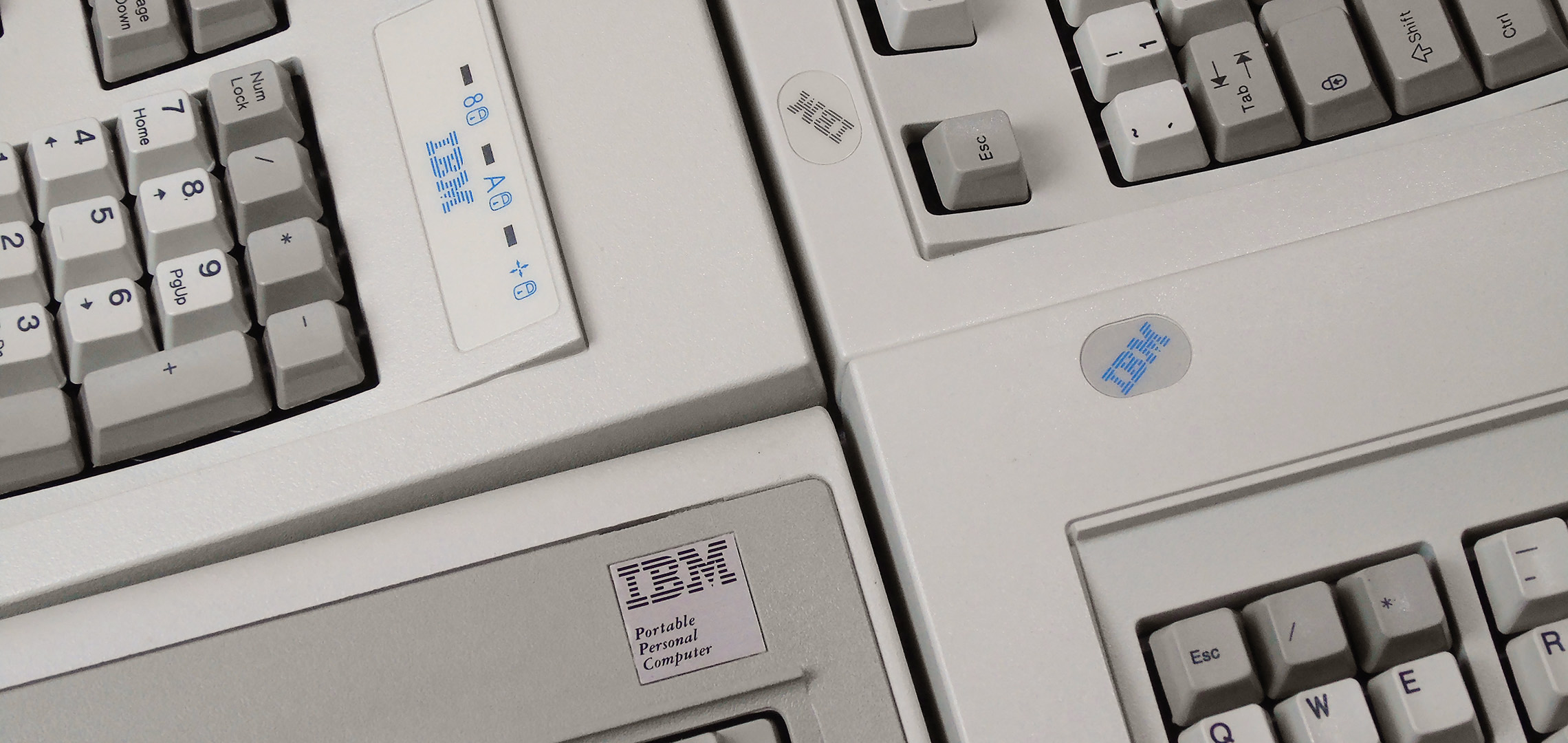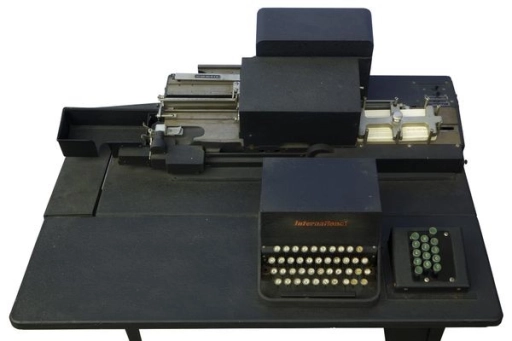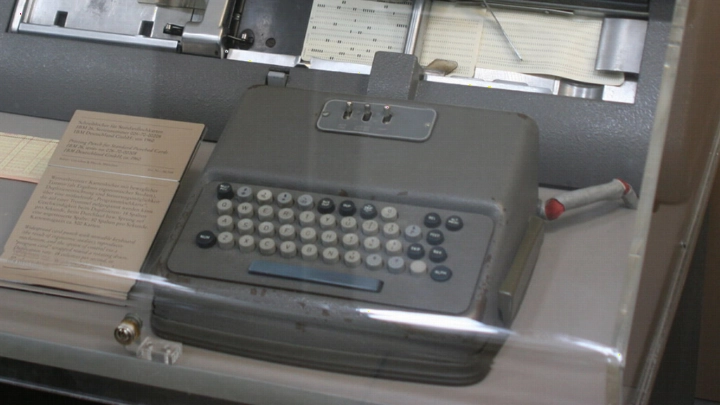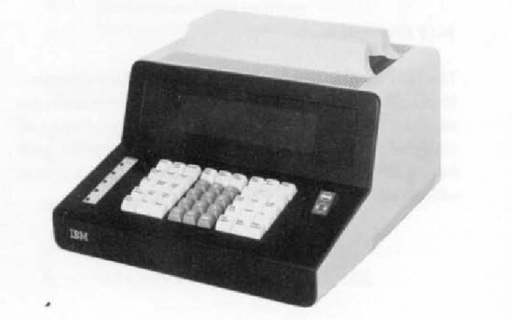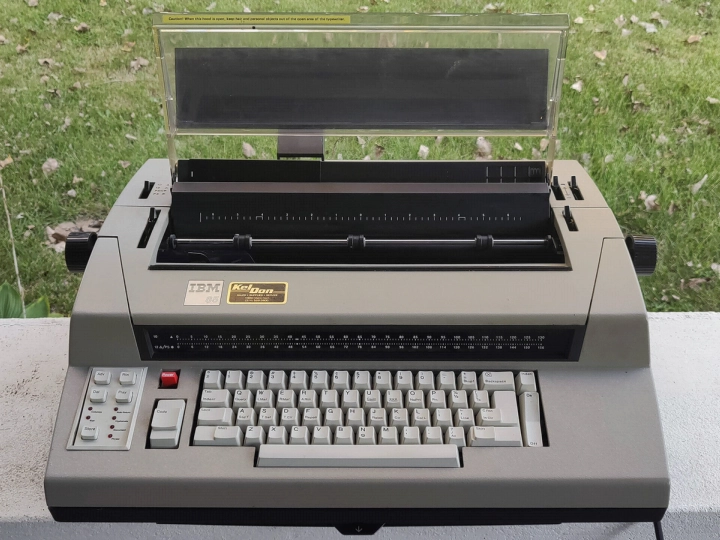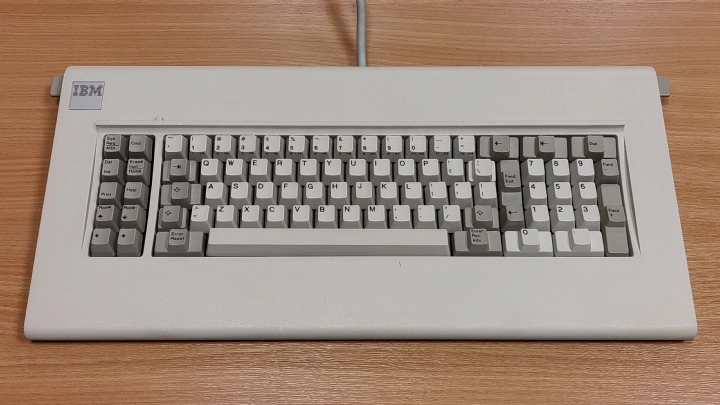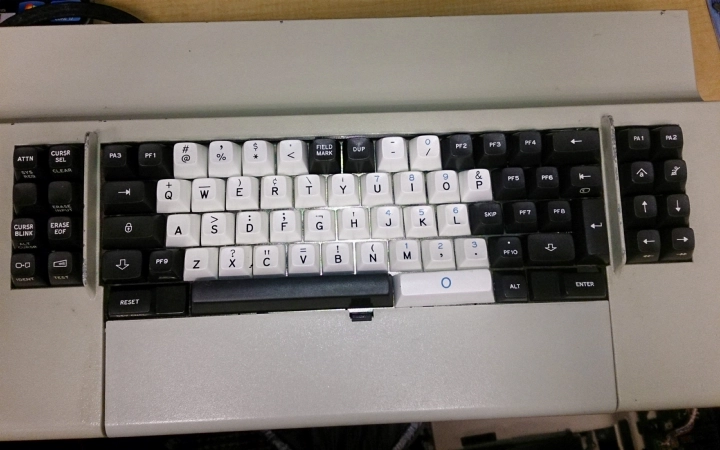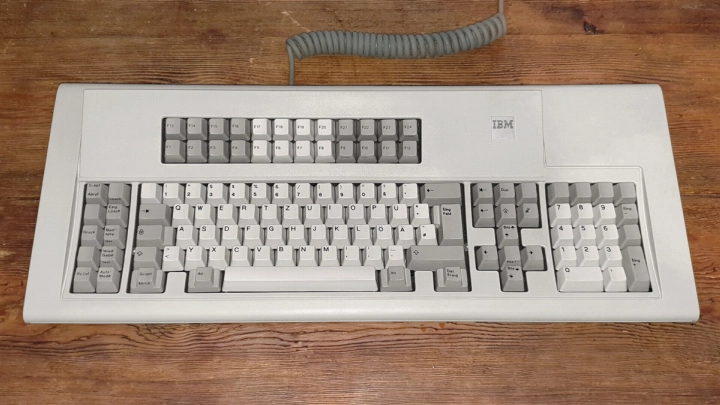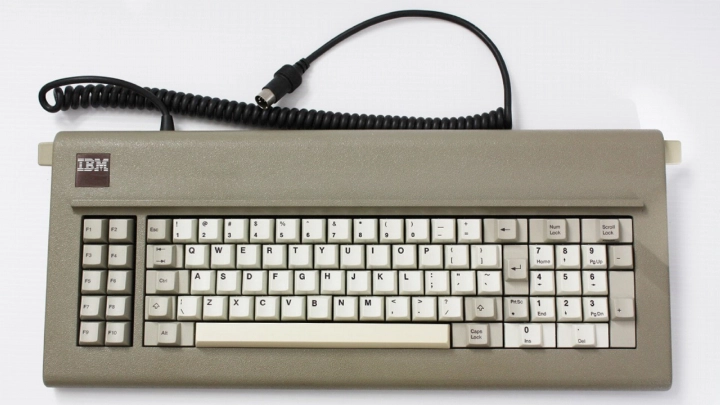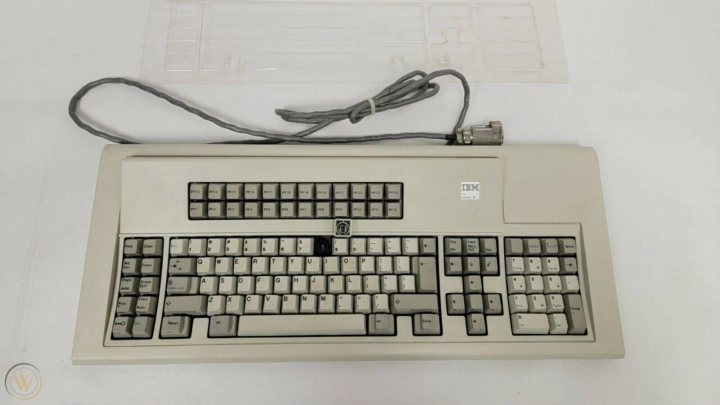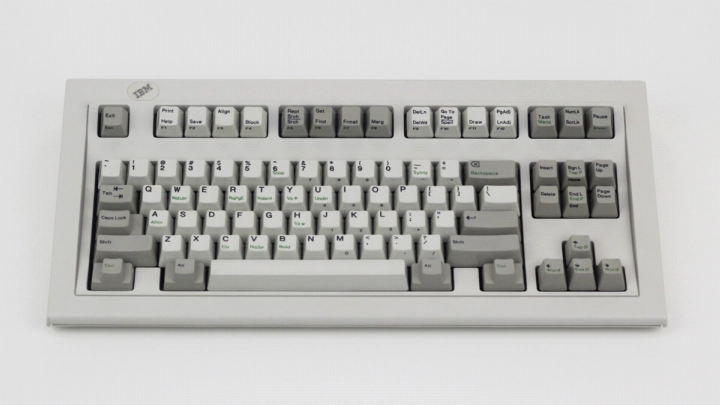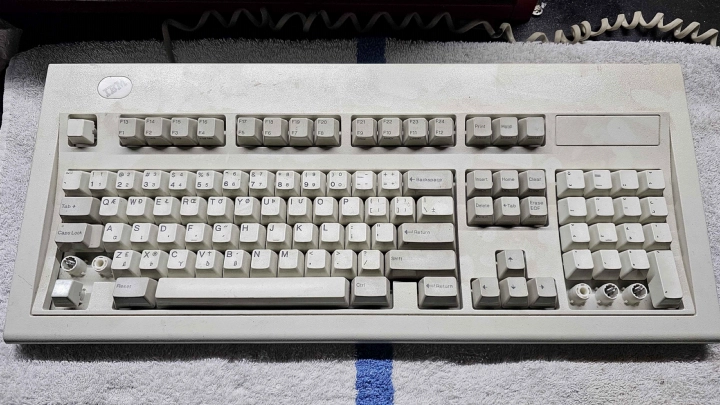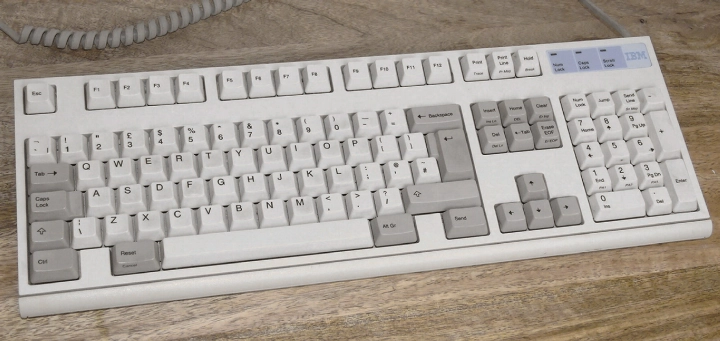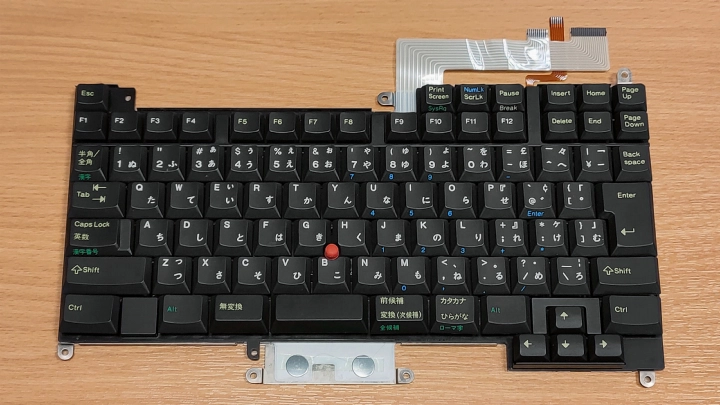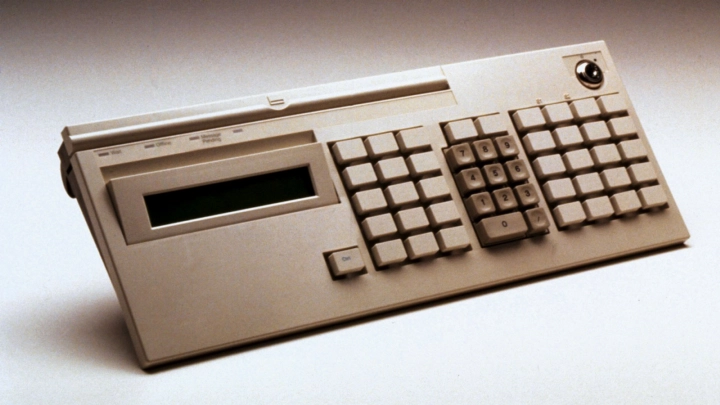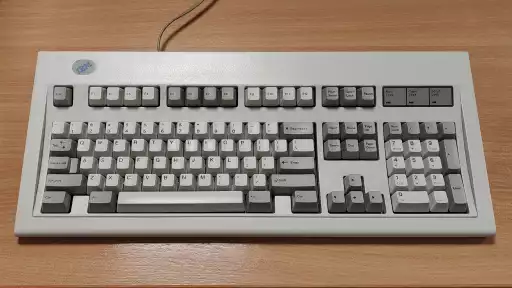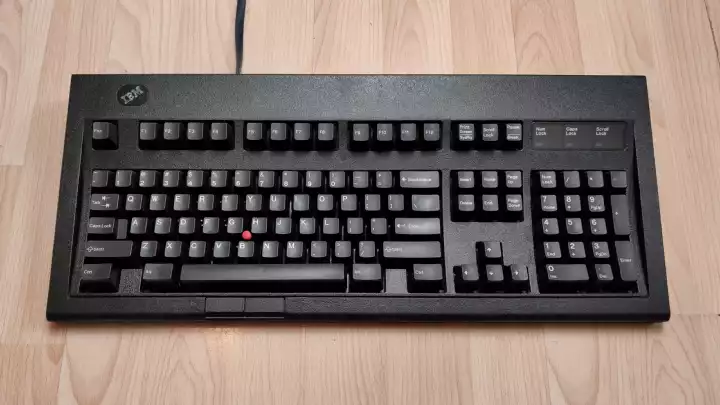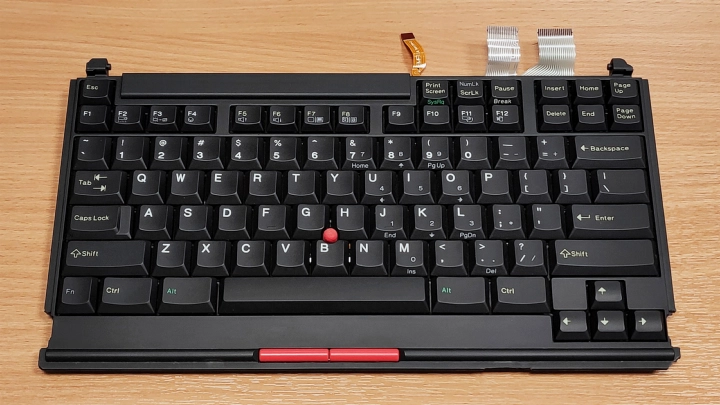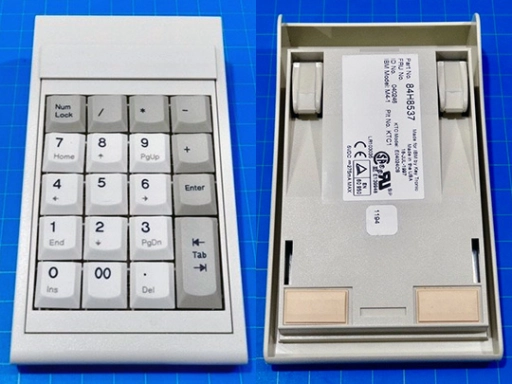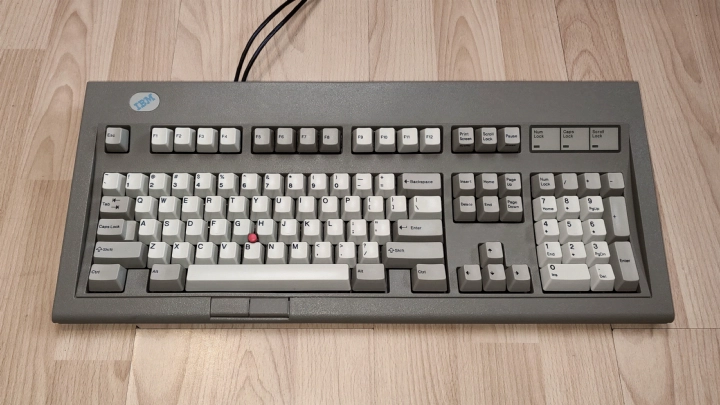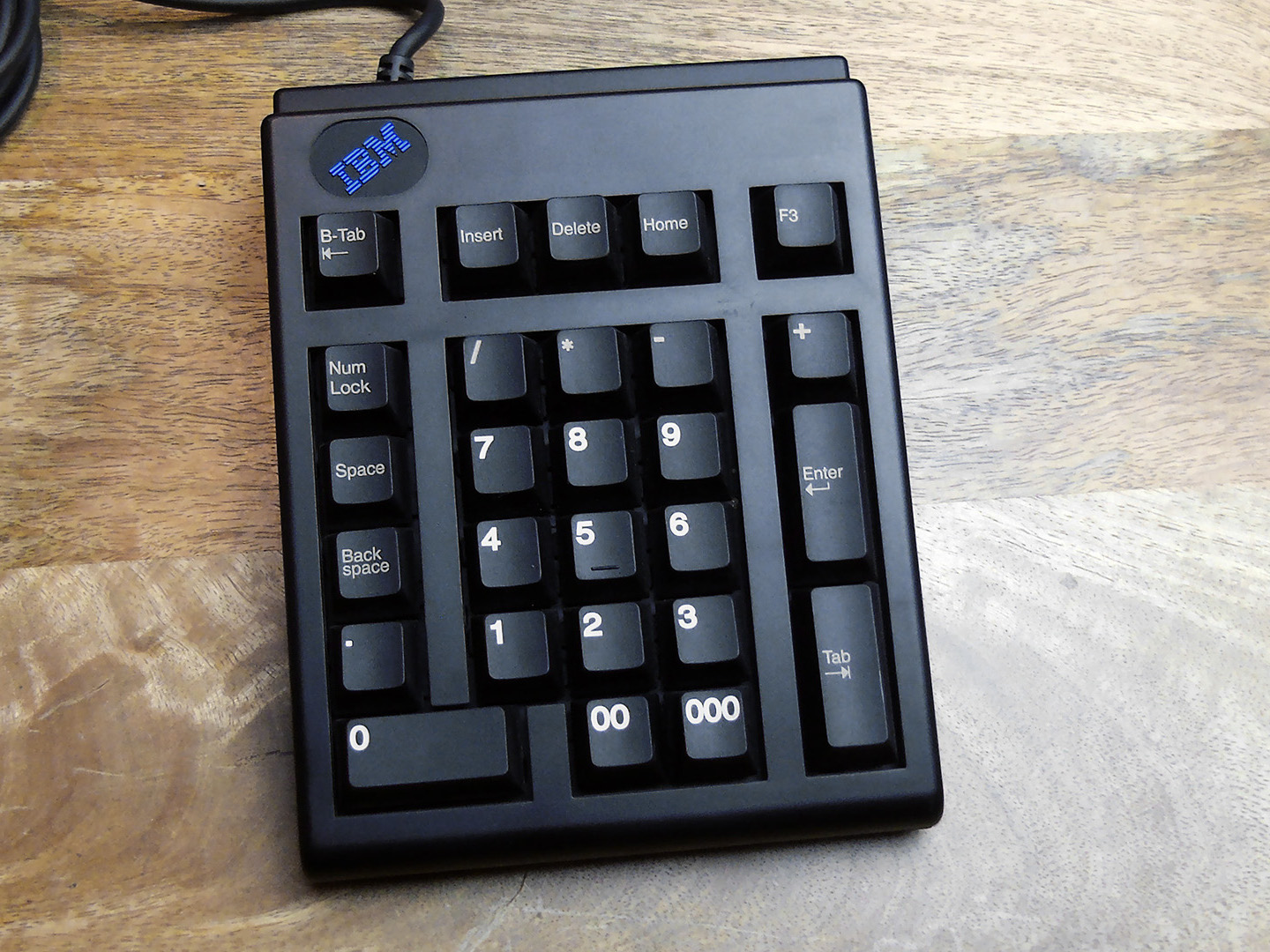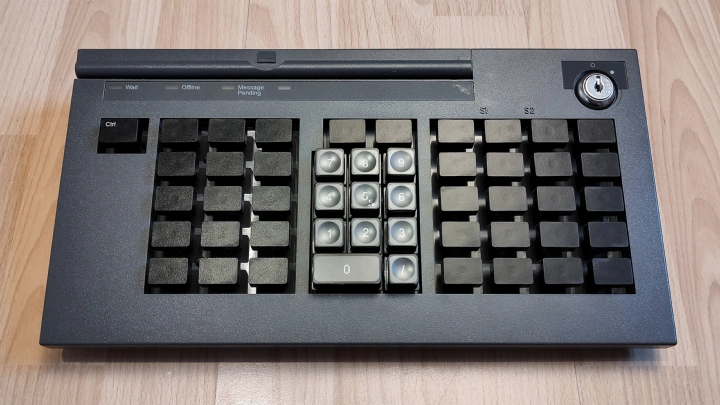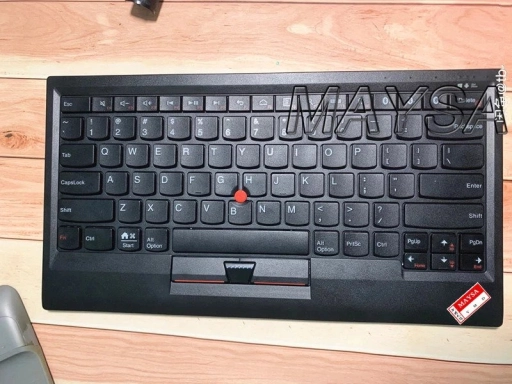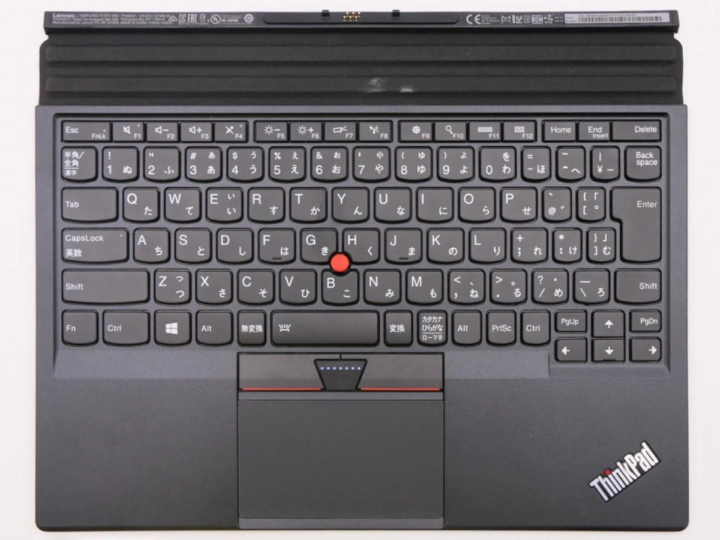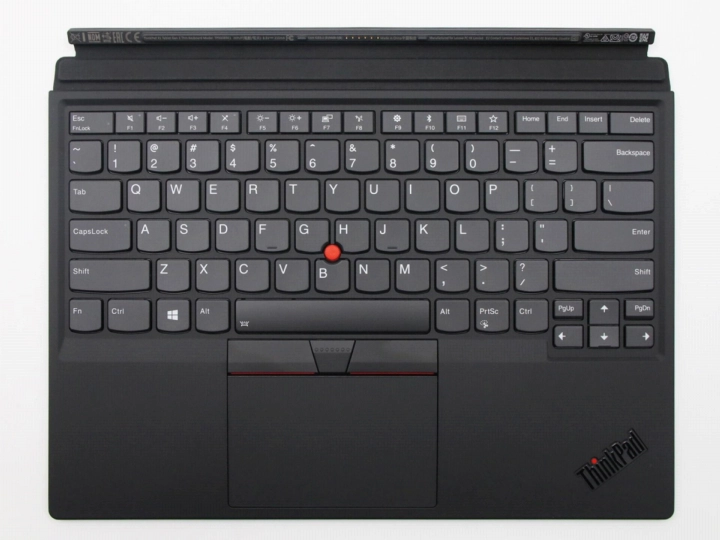Notice 2024-03-01
The ASK Keyboard Directory is still a work in progress. Whilst it has been improved greatly over 2022 and 2023, there is still much work to be done over 2024. So please excuse missing descriptions and obvious missing keyboards.
The Keyboard Directory is an exhaustive illustrated list of IBM and family keyboards with basic information and common (usually Americas, EMEA and Japan) part numbers given and usually link on where to find out more. Originally envisioned as a Yellow Pages for keyboards (if you will), the Keyboard Directory intends to build a complete picture of the IBM and family keyboard timeline for people new to such keyboards to see and get a feel for or simply provide viewing pleasure. 278 distinct keyboards are listed in the directory.
Directory
Hollerith 001 Mechanical Card Punch
aka IBM 001 Mechanical Card Punch
First patented in 1901, the Hollerith/IBM 001 was the first keypunch (ie, first card punch that operated from keyboard input of some kind).
🔗IBM 011 Electric Card Punch
The first electric keypunch, where cards are punched by electromagnets instead of musclepower.
🔗IBM 012 Electric Duplicating Card Punch
The first IBM keypunch capable of duplicating columns from one card to another.
🔗IBM 015 Motor Driven Electric Card Punch
IBM's first keypunch with automatic feeding and ejecting mechanisms.
🔗IBM 016 Motor Driven Electric Duplicating Card Punch
IBM's first duplicating keypunch with automatic feeding and ejecting mechanisms.
🔗IBM Radiotype Transmissing Typewriter
A modified IBM Electric Typewriter Model 01 equipped with an attached transmitter that could communicate with a remote Radiotype via radio or wire, outputting keystrokes via a keyboardless receiving typewriter.
🔗IBM 032 Alphabetical Printing Card Punch
IBM's first keypunch capable of alphanumeric punching and printing the character typed on top of the punched card.
🔗IBM 031 Alphabetical Duplicating Card Punch
A duplicating IBM keypunch with numeric keypad known to be used in statistical and astronomical applications.
🔗IBM 040 Tape Controlled Card Punch
An IBM keypunch capable of converting the code of paper tape to punched cards and used extensively during World War II by the U.S. Military.
🔗IBM 024/026/056 Card Punch Combination Keyboard
The 45-key alphanumeric keyboard for IBM 024 and 026 Card Punches and IBM 056 Card Verifier, electrically separable and thus the common ancestor to all modern IBM keyboards.
🔗IBM 024/026/056 Card Punch Numeric Keyboard
The 21-key numeric keypad for IBM 024 and 026 Card Punches and IBM 056 Card Verifier.
🔗IBM 797 Documenting Numbering Punch
A special keypunch for numbering documents and believed to be used for Canadian censuses.
🔗IBM 7150 Console Typewriter & Operating Keyboard
The multi-purpose input/output component for the IBM 7070 Data Processing System. It was amongst the earliest known printer-keyboards and comprised of two separate input devices within one housing - the Console Typewriter and the Operating Keyboard.
🔗IBM 7900 Inquiry Station Typewriter Keyboard
The querying input/output component for the IBM 7070 Data Processing System. It was amongst the earliest known printer-keyboards.
🔗IBM 1052 I/O Printer-Keyboard
1052a/1052 Model 6 variant
An IBM 024/026 keypunch keyboard paired with a Selectric-based printing mechanism used as part of the IBM 1050 Data Communications System, which connected to other 1050s or IBM 1400, 7000 or System/360 computers. It featured one bank of 1x4 buttons and 3 toggle switches.
🔗IBM 1816 Printer-Keyboard
An IBM 024/026 keypunch keyboard paired with a Selectric-based printing mechanism used as part of the IBM 1800 Data Acquisition and Control System.
🔗IBM 1052-7 I/O Printer-Keyboard
A variant of the IBM 1052 intended specifically for IBM 2150 Consoles. It featured one bank of 1x4 buttons and 19 toggle switches.
🔗IBM 1130 Computing System Console Keyboard
An IBM 029 keypunch keyboard paired with a Selectric-based IBM 1053 Console Printer used as part of the IBM 1130 Computing System, a then low-cost computer for price-sensitive computing-intensive technical markets like education and engineering.
🔗IBM 2740 Communications Terminal Model 1
A Selectric-based IBM 72 I/O Typewriter modified with SLT electronics. It could communicate with other terminals or a computer such as an IBM System/360. 2740-1 is the non-buffered version of this terminal.
🔗IBM 2740 Communications Terminal Model 2
A Selectric-based IBM 72 I/O Typewriter modified with SLT electronics. It could communicate with other terminals or a computer such as an IBM System/360. 2740-2 is the buffered version of this terminal that could store up to 120 characters and print them for verification before transmission.
🔗IBM 2741 Communications Terminal
A Selectric-based IBM 72 I/O Typewriter modified with SLT electronics. It has a RS-232-C serial interface to connect to IBM System/360 computers.
🔗IBM 5471 Printer-Keyboard
The IBM 5471 was a printer-keyboard available for IBM System/3 computers with an IBM 5444 Disk Storage Drive attached. It was designed to perform online inquiries, key entry of data, operator/system communications and operate as a secondary printer.
🔗IBM 2772 Multi-Purpose Control Unit Keyboard
The IBM 2772 and its keyboard were used with the IBM 2770 Data Communication System. The keyboard unit was used for data entry and controlling the system.
🔗IBM 5475 Data Entry Keyboard Attachment
The IBM 5475 was a 64-character keyboard with several toggle switches available for IBM System/3 computers.
🔗IBM 5496 Data Recorder Keyboard
The IBM 5496 was a 64-character keyboard available for IBM System/3 computers as part of its Data Recorder system used to provide punched and printed source documents for the host computer.
🔗IBM 5404/5406 System/3 Operator Keyboard Console
The IBM System/3 Operator Keyboard Console was largest keyboard available for any IBM System/3 config. It was used for entering data into storage, controlling system functions and controlling certain program operations and printer operations via its command keys.
🔗IBM 3210 Model 1 Console Printer-Keyboard
Model SPK
IBM-made combined 51-key IBM Card Punch style keyboard and Selectric I/O-II printer designed for use as an operator terminal on IBM System/370 mainframe computer models 135, 145 and 155. This model 1 version of 3210 is table-mounted and its keyboard is flanked on both sides by a control panel with 7 keys and 5 indicator lights.
🔗IBM 3210 Model 2 Console Printer-Keyboard
Model DPK
IBM-made combined 52-key IBM Card Punch style keyboard and Selectric I/O-II printer designed for use as an operator terminal on IBM System/370 mainframe computer models 135, 145 and 155. This model 2 version of 3210 is pedastal-mounted and its keyboard is flanked on both sides by a control panel with 8 keys and 4 indicator lights.
🔗IBM 3215 Console Printer-Keyboard
Model MPK, also known as the IBM 3215 Wire Matrix Printer
IBM-made combined 51-key IBM Elastic Diaphgram encoded keyboard and dot matrix printer designed for use as an operator terminal on IBM System/370 mainframe computer models 135, 145 and 155. It is table-mounted and its keyboard is flanked on both sides by a control panel with 7 keys and 5 indicator lights. Compared to its 3210 siblings with their Selectric-based printers, the 3215's dot matrix one was designed to be significantly faster.
🔗IBM 3275/3277 Display Station Type A 66-key Typewriter Keyboard
327X-66 type Model A
The original Micro Switch-made 66-key [data] typewriter keyboard for the IBM 3275 and 3277 Display Stations.
🔗IBM 3672 Executive Console
The 178-key keyboard component of the IBM 3670 Brokerage Communications System.
🔗IBM 3158 66-key Display Console Keyboard
S370-T1 type Model B
IBM-made 66-key operator console keyboard for the IBM System/370 Model 158 mainframe computer's 3158 Display Console (also known as the 3158 Operator Console). It was integrated into the large platform the console's CRT display was attached to. The keyboard notably had a green "START" key and red "STOP" and "IRPT" (interrupt) keys. It's also the earliest known IBM Model B (beam spring key-switch) based keyboard.
🔗IBM 3115/3125 Operator Console Keyboard
S370-T2 type Model B
IBM-made 66-key operator console keyboard for the IBM System/370 Models 115 and 125 mainframe computers' 3115 and 3125 (respectively) Operator Consoles. It was partially integrated to the base of the console's CRT display. The keyboard notably had a green "START" key and a red "STOP" key, and an Operator Control Panel (OCP) with buttons for powering the host system on and off, performing low-level was detected, and an emergency pull to cut power to the host system immediately. There were two versions of 3115/3125 keyboard, and this was the original one with relatively thick side bezels.
🔗IBM 3275/3277 Display Station Type B 66-key Typewriter Keyboard
327X-66 type Model B
The revised IBM-made 66-key [data] typewriter keyboard for the IBM 3275 and 3277 Display Stations.
🔗IBM 3275/3277 Display Station Type B 78-key Typewriter Keyboard
327X-78 type Model B
The revised IBM-made 78-key [data] typewriter keyboard for the IBM 3275 and 3277 Display Stations.
🔗IBM 3604 Keyboard Display Alphanumeric Keyboard
The larger alphanumeric keyboard for the IBM 3604 Keyboard Display.
🔗IBM 3604 Keyboard Display Numeric/Data Entry Keyboard
The smaller numeric and data entry keyboard for the IBM 3604 Keyboard Display.
🔗IBM 3115/3125 Revised Operator Console Keyboard
S370-T3 type Model B
IBM-made 66-key operator console keyboard for the IBM System/370 Models 115 and 125 mainframe computers' 3115 and 3125 (respectively) Operator Consoles. It was partially integrated to the base of the console's CRT display. The keyboard notably had a green "START" key and red "STOP" and "IRPT" keys, and an Operator Control Panel (OCP) with buttons for powering the host system on and off, performing low-level was detected, and an emergency pull to cut power to the host system immediately. There were two versions of 3115/3125 keyboard, and this was the revised one with relatively thin side bezels.
🔗IBM 3793 Printer-Keyboard
A Selectric I/O II printer-keyboard for the IBM 3790 Communications System. It was a data entry operator station that also included various control keys, operator guidance indicators and system indicators.
🔗IBM 5320 System/32 Keyboard Assembly
The integrated keyboard assembly of the IBM 5320 System/32 midrange computer.
🔗IBM 3138/3148 78-key Display Console Keyboard
S370-T4 type Model B
IBM-made 78-key operator console keyboard for the IBM System/370 Models 138 and 148 mainframe computers' 3138 and 3148 (respectively) Display Consoles. It was integrated into the large platform the console's CRT display was attached to. It's essentially a version of the IBM 3158 66-key Display Console Keyboard but with the added 12-key program function keypad. Unusually for an IBM operator console keyboard since 1972, it didn't have coloured "START" and "STOP" keys.
🔗IBM 5251/5252 Display Station Data Entry Keyboard
525X-66 type Model B
IBM-made 66-key (most) or 69-key (Katakana) data entry keyboard for the IBM 5251 Display Station and 5252 Dual Display Station, the inaugural terminals of the IBM 5250 family for IBM's midrange computers. The keyboard is a lot less common than its 83-key typewriter counterpart and uses a layout similar to IBM Card Punch keyboards. They had an internal solenoid clicker assembly and a cut-out above the keys to hold a template for writing down the names of functions assigned to various keys. They had a short, grey cable terminating in a female DB-25 plug.
🔗IBM 5251/5252 Display Station Typewriter Keyboard
525X-83 type Model B
IBM-made 83-key (most) or 85-key (Katakana and Hebrew) typewriter keyboard for the IBM 5251 Display Station and 5252 Dual Display Station, the inaugural terminals of the IBM 5250 family for IBM's midrange computers. The keyboard is a lot more common than its 66-key data entry counterpart and introduced the 5250-style typewriter physical and functional keyboard layouts that would later prove influential for future terminal and early IBM PC keyboards. They had an internal solenoid clicker assembly and a cut-out above the keys to hold a template for writing down the names of functions assigned to various keys. They had a short, grey cable terminating in a female DB-25 plug.
🔗IBM 3036 Dual Console Keyboard
S370-T5 type Model B
IBM-made 66-key operator console keyboard for the System/370-compatible IBM 303X Attached Processor Complex series' 3036 Dual Console. The 3036 consisted of two display consoles with separate keyboards attached on a right-angled deck. It resembled the IBM 3115/3125 Operator Console Keyboards but lacking their Operator Console Panels with additional controls. The keyboard notably had a green "START" key and red "STOP" and "IRPT" keys.
🔗IBM 3251/3276/3278/3279/8775 Display Station 75-key Data Entry Keyboard
327X-75 type Model B
eg, P/Ns 1742710, 4941907, 4941915, 4941917, 4941919, 4941921, 4941923, 4941927, 4941929, 4941931, 4941935, 4941937, 4941939
IBM-made 75-key (most) or 76-key (Japan) data entry keyboard for primarily the IBM 3276 Control Unit Display Station, 3278 Display Station and 3279 Color Display Station, but was also used with the IBM 3251 Display Station and 8775 Display Terminal. This variant is the "data entry 1" version and has a numeric lock.
🔗IBM 3251/3276/3278/3279/8775 Display Station 75-key Typewriter Keyboard
327X-75 type Model B
eg, P/Ns 4941777, 4941783, 4941807, 4941813, 4941819, 4941825, 4941831, 4941835, 4941847, 4941853, 4941859, 4941871, 4941877
IBM-made 75-key (most) or 76-key (Japan) [data] typewriter keyboard for primarily the IBM 3276 Control Unit Display Station, 3278 Display Station and 3279 Color Display Station, but was also used with the IBM 3251 Display Station and 8775 Display Terminal. This variant doesn't have a numeric lock.
🔗IBM Electronic Typewriter 50/60/75 Keyboard Assembly
eg, P/N 1440401
54-key integrated keyboard assembly with On/Off rocker switch for IBM Electronic Typewriters models 50, 60 and 75, IBM's first typewriters that were electronic rather than [electro]mechanical (ie, able to perform some amount of internal processing via electronics than rely on mechanical elements). The keyboard assembly seems inspired by IBM Card Punch keyboards but uses a series of magnetic reed sensors for key-stroke sensing. The keys can lock, which requires the host typewriter to unlock them.
🔗IBM 4978 Display Station Basic Keyboard
RPQ D02057
D02057 RPQ keyboard option for IBM 4978s with 81 keys including a 11-key numeric keypad for "adding machine" like operation and intended for data entry.
🔗IBM 3732 Text Display Station Typewriter Keyboard
3732 type Model B
IBM-made 74-key (BAE enter and ANSI left shift) or 75-key (ISO) typewriter keyboard for the IBM 3730 Distributed Office Communication System's IBM 3732 Text Display Station, designed for word processing operations.
🔗IBM 3276/3278/3279 Display Station 87-key Attribute Select Typewriter Keyboard
327X-87 type Model B
eg, P/Ns 4419251, 4419255, 4419259, 4419259, 4419263, 4419283, 4419291, 4419295, 4419299, 4419303, 4419307, 4419311, 4419327
IBM-made 87-key (most) or 88-key (Japan) [data] typewriter keyboard for IBM 3276 Control Unit Display Station, 3278 Display Station and 3279 Color Display Station. This variant is intended operating IBM 3270 extended attribute (all terminals) and colour (3279 only) support, and doesn't have a numeric lock.
🔗IBM 3276/3278/3279 Display Station 87-key Typewriter/APL Keyboard
327X-87 type Model B
eg, P/Ns 1742718, 4941982, 4941984, 4941986, 4941987, 4941989, 4941990, 4941992, 4941993, 4941994, 4941996, 4941998
IBM-made 87-key (most) or 88-key (Japan) [data] typewriter keyboard for IBM 3276 Control Unit Display Station, 3278 Display Station and 3279 Color Display Station. This variant has APL sublegends and has a numeric lock.
🔗IBM 3278 Model 2A Display Console 75-key Operator Control Panel Keyboard
327X-OC type Model B, IBM 43X1 w/o channel-to-channel variant
eg, P/Ns 4942001, 4942007, 4942010, 4942016, 4942022, 4942025, 4942028, 4942031, 4942034, 4942040, 4942043, 4942046, 4942052, 4942055, 4942058
IBM-made 75-key (most) or 76-key (Japanese) operator console keyboard for the IBM 3270 lineage IBM 3278 Model 2A Display Console, a console for the System/370 compatible IBM 4331, 4341, 4361 and 4381 Processors. The keyboard notably had a green "START" key and a red "STOP" key. This version of the OCP keyboard does not have the possible channel-to-channel feature or a numeric lock.
🔗IBM 3278-2A/3279-2C Display Console 75-key Operator Control Panel Keyboard
327X-OC type Model B, IBM 308X w/ SCCP variant
eg, P/N 4942247
IBM-made 75-key (most) or 76-key (Japanese) operator console keyboard for the IBM 3270 lineage IBM 3278 Model 2A Display Console and 3279 Model 2C Color Display Console, both possible consoles for the System/370 compatible IBM 3081 Processor Complex. The keyboard notably had a green "START" key and a red "STOP" key. This version has an operator control panel one blank grey switch and blue "Lamp Test" and "IML" switches, and "PC Power" is prominently titled above 3 LEDs. The keyboard was additionally designated as a typewriter-style keyboard with "SCCP" (presumed to stand for "system console control panel", referring to this panel arrangement). This version of the OCP keyboard has a numeric lock.
🔗IBM 3278-2A/3279-2C Display Console 75-key Operator Control Panel Keyboard
327X-OC type Model B, IBM 43X1 w/o channel-to-channel and power-on variant
eg, P/Ns 4942161, 4942163, 4942164, 4942166, 4942168, 4942169, 4942170, 4942171, 4942172, 4942174, 4942175, 4942176, 4942178, 4942179, 4942180
IBM-made 75-key (most) or 76-key (Japanese) operator console keyboard for the IBM 3270 lineage IBM 3278 Model 2A Display Console and 3279 Model 2C Color Display Console, both consoles for the System/370 compatible IBM 4331, 4341, 4361 and 4381 Processors. The keyboard notably had a green "START" key and a red "STOP" key. This version of the OCP does not have the possible channel-to-channel and power-on features or a numeric lock.
🔗IBM 5924-T01 Multi-Shift Kanji Keyboard
A 254-key 12-shift kanji keyboard used by the IBM 3278 Model 52 Display Station and IBM 5924-T01 Kanji Keypunch components of IBM 3270 Kanji Information Display System.
🔗IBM 5253/5254 Display Station Electronic Keyboard
525X-82 type Model B, 92-character variant
eg, P/N 7363830
IBM-made 82-key typewriter-style keyboard for the IBM 5253 Display Station and 5254 Dual Display Station (both terminals for the IBM 5520 Administrative System). They were intended for facilitating document creation and editing, and management of their storage. They could also support an IBM 3270 emulation mode. This variant is the 92-character keyboard with an ANSI-like 2.25-unit left shift key and a "BAE" (large backwards-L) style return key. They had a 32Ω, 0.2W speaker inside though its purpose is presently unclear. The keyboard itself and its layout became the basis of the slightly later IBM Displaywriter Keyboard.
🔗IBM 5253/5254 Display Station Electronic Keyboard
525X-82 type Model B, 96-character variant
eg, P/N 7363831
IBM-made 84-key typewriter-style keyboard for the IBM 5253 Display Station and 5254 Dual Display Station (both terminals for the IBM 5520 Administrative System). They were intended for facilitating document creation and editing, and management of their storage. They could also support an IBM 3270 emulation mode. This variant is the 96-character keyboard with a 1.25-unit left shift key and an "ISO-style" return key. They had a 32Ω, 0.2W speaker inside though its purpose is presently unclear. The keyboard itself and its layout became the basis of the slightly later IBM Displaywriter Keyboard.
🔗IBM 5281/5282/5285/5286 Data Station Typewriter Keyboard
528X-83 type Model B, aka "beamfoot"
IBM-made 83-key [data] typewriter keyboard for IBM 5281 Data Station, 5282 Dual Data Station, 5285 Programmable Data Station and 5286 Dual Programmable Data Station. It has a 32Ω, 0.2W speaker inside.
🔗IBM 6580 Displaywriter Display Station Type A Keyboard Module
630X type Model B, 92-character variant
IBM-made 82-key keyboard for IBM Displaywriter System's 6580 Display Station intended for word processing. The 82-key version had ANSI-style left shift and "BAE" backwards-L style return keys and was designed to support 92 characters.
🔗IBM 6580 Displaywriter Display Station Type A Keyboard Module
630X type Model B, 96-character variant
eg, P/Ns 2682678, 2683210, 2683230
IBM-made 84-key keyboard for IBM Displaywriter System's 6580 Display Station intended for word processing. The 84-key version had ISO-style left shift and return keys and was designed to support 96 characters.
🔗IBM 5322 System/23 Datamaster Keyboard Assembly
eg, P/Ns 1643374, 1643377, 1643380, 1643383, 1643395, 1860765, 1860768, 1860771, 1860777, 1860783
IBM-made 83-key integrated keyboard assembly for the IBM System/23 Datamaster (IBM 5322 "desk-top" variant). This keyboard assembly is presently the earliest confirmed Model F keyboard design and buckling spring keyboard at large. The layout is derived from that of the IBM 5251/5252 Typewriter Keyboard but makes minor tweaks to establish the true XT-style physical layout.
🔗IBM Personal Computer Keyboard
aka "Model F/XT"
eg, P/Ns 1501100, 1501101, 1501102, 1501104, 1501105, 1801449
IBM-made 83-key keyboard for the IBM 5150 Personal Computer and 5160 Personal Computer XT. It's famous for being the original IBM PC keyboard and is also the earliest known discrete Model F keyboard (ie, not integrated into a larger system) and introduced the XT-style functional layout. It has a black, coiled cable terminating in a 5-pin DIN plug, single-setting riser feet accessible from the sides, and 4 cork feet to prevent sliding. Two variants exist; a Type 1 keyboard with a metal-jacketed DIN plug that supports a RESET line and a Type 2 keyboard with a plastic-jacketed DIN plug that doesn't.
🔗IBM Electronic Typewriter 65/85/95 Keyboard Assembly
eg, P/Ns 1305676, 1305677, 1305679, 1305687, 1415880, 1437057
54-key integrated keyboard assembly with On/Off rocker switch for the IBM Electronic Typewriter models 65, 85 and 95, the second generation of IBM's first typewriters that were electronic rather than [electro]mechanical (ie, able to perform some amount of internal processing via electronics than rely on mechanical elements). Compared to their model 50/60/75 predecessors, the keyboard assembly is a lot thinner thanks to being based on Model F capacitive buckling spring technology and its keys can no longer lock themselves. Despite being Model F based, these keyboard assemblies unusually have melted plastic rivets like a Model M based keyboard assembly.
🔗IBM 5324 System/23 Datamaster Floortop Keyboard Module
eg, P/Ns 8257796, 8529401, 8529404, 8529412, 8529416, 8529418, 8529420, 8529422, 8529424, 8529428
IBM-made 83-key discrete keyboard for the IBM System/23 Datamaster (IBM 5324 "floor-top" variant). This version of the Datamaster and this keyboard were announced later than its 5322 integrated counterparts. The keyboard resembles the slightly earlier IBM 5291/5292 Display Station Keyboard with its large bezels (compared to the IBM Personal Computer Keyboard) but is larger still and only has one adjustable riser feet size. The layout is derived from that of the IBM 5251/5252 Typewriter Keyboard but makes minor tweaks to establish the true XT-style physical layout.
🔗IBM 5291/5292 Display Station Keyboard
529X type Model F
eg, P/Ns 1397950, 4176191, 5642852, 5643009, 5643010, 5643011, 5643012, 5643014, 5643024, 7363290
IBM or Lexmark made 83-key typewriter-style keyboard for the IBM 5291 Display Station and IBM 5292 Color Display Station, both IBM 5250-compatible terminals. The keyboard resembles the IBM 5150/5160 Personal Computer Keyboard but with enlarged bezels and its characteristic three-setting riser-style feet. This earned it the community nickname "bigfoot" Model F. The keyboard also lacks its own controller and thus doesn't produce its own scancodes (the electronics inside only allow for capacitance sensing for the host terminal to control itself). The keyboard was available in two variants that were identical apart from the cable; a Type 1 keyboard for IBM 5291 Model 1s with an integrated connection via a 14-pin IDC-style connector and a Type 2 keyboard for 5291 Model 2s with an external connection via a DA-15 plug.
🔗IBM 8775 Display Terminal 87-key EBCDIC Typewriter/Text Entry and Edit Keyboard
327X-87 type Model B, feature no. 4670
eg, P/N 5147351
IBM-made 87-key typewriter-like keyboard for the IBM 8775 Display Terminal (a terminal for the IBM 8100 Information System that supported IBM 3270 datastreams over serial instead of coax). This feature number 4670 keyboard was introduced late for a Model B keyboard variant and was intended for IBM 8775s running Interactive Display Text Facility (IDTF, a licensed program that enabled the host terminal to be used in both data and text applications). On top of the base IBM Base Keyboard/3270 typewriter-style layout, this keyboard had various application-specific green front-printed legends and special numeric keypad keycaps designed to hold a reversible overlay card in place. On one side of this overlay card were the standard program-function key assignments, and on the other were functions that apply when the 8775 is used with the IDTF program. Typical for a 327X-87 type Model B is the keyboard's internal clicker assembly and palm-rest compartment for documentation.
🔗IBM System 9001 Standard Keyboard
aka IBM Instruments Computer System 9000 Keyboard
eg, P/N 4780898
IBM-made 83-key keyboard for the original IBM Instruments Computer System 9000 laboratory computer model (later known as the IBM System 9001 Bench-Top Computer). It's a variant of the IBM Personal Computer Keyboard that lacks any sort of adjustable feet and has its cable sprouting from the keyboard's lefthand side instead of its rear. It has a black, coiled cable terminating in a 5-pin DIN plug and 4 cork feet to prevent sliding. The "Standard" in the keyboard's name contrasts it with the later IBM System 9002 Hybrid Keyboard.
🔗IBM 6580 Displaywriter Display Station Type B Keyboard
630X type Model F, 96-character variant
eg, P/N 2684674
IBM-made 84-key keyboard for IBM Displaywriter System's 6580 Display Station intended for word processing. The 84-key version had ISO-style left shift and return keys and was designed to support 96 characters. It has an internal buzzer and a permanently attached cable terminating in a DA-15 plug. This keyboard has a Model B-based Type A predecessor.
🔗IBM 4704 Display Station Model 100 Function Keyboard
472X-100 type Model F, aka "Model F50"
eg, P/Ns 6019273, 6019312, 6019315, 6019316, 6019317, 6019318
IBM-made 50-key bank teller keyboard for IBM 4704 Model 1, 2 and 3 Display Terminals, components of the IBM 4700 Finance Communication System. This keyboard layout is divided into 3 matrix sections that were originally facilitating 45 customisable (relegendable) keys and 5 fixed-function keys. The keyboard was envisioned to allow basic data entry, account management and transaction management. The keyboard's cover is made of zinc and has a volume-adjustable buzzer on the bottom intended to provide an audible alarm to the user on certain system and application program conditions.
🔗IBM 4704 Display Station Model 200 Alphameric Keyboard
472X-200 type Model F, aka "Model F62" or "kishsaver"
eg, P/Ns 6019284, 6019319, 6019324, 6019326, 6019328, 6019329, 6019334, 6019337
IBM-made 62-key typewriter-style keyboard for IBM 4704 Model 1, 2 and 3 Display Terminals, components of the IBM 4700 Finance Communication System. The keyboard is a particularly early example of a 60% keyboard and was designed to allow for full alphanumeric input capability but limited programmed-function capability compared to the 50-key IBM 4704-100 Function Keyboard. As such, the host terminals allowed a Model 100 keyboard and this Model 200 keyboard to be combined to provide both functionalities effectively. The keyboard on its own was intended for personal consultants and administrative personnel. The keyboard's cover is made of zinc and has a volume-adjustable buzzer on the bottom intended to provide an audible alarm to the user on certain system and application program conditions.
🔗IBM 4704 Display Station Model 300 Expanded Alphameric Keyboard
472X-300 type Model F, aka "Model F77"
eg, P/Ns 6019303, 6019338, 6019343, 6019345, 6019347, 6019348, 6019353, 6019356
IBM-made 77-key typewriter-style keyboard for IBM 4704 Model 1, 2 and 3 Display Terminals, components of the IBM 4700 Finance Communication System. This keyboard is an expanded version of the 62-key IBM 4704-200 Alphameric Keyboard with 15 extra relegendable keys for tailored alphabetic input or programmed functions. Like its smaller sibling, this keyboard was intended for personal consultants and administrative personnel. The keyboard's cover is made of zinc and has a volume-adjustable buzzer on the bottom intended to provide an audible alarm to the user on certain system and application program conditions.
🔗IBM 3104-B1/3178-C1 Data Entry Keyboard
31XX-75 type Model F
eg, P/N 5640991
75-key (rest of world) or 76-key (Japanese) data entry keyboard for the 3270-family IBM 3104 Model B1 Display Terminal and IBM 3178 Model C1 Display Station. It was a part of the continuation of IBM 3270 Base Keyboards that originated in the IBM Model B keyboard family era. It has an internal solenoid clicker assembly and a blue-coloured display case toggle switch.
🔗IBM 3104-B2/3178-C2 Typewriter Keyboard
31XX-87 type Model F
eg, P/Ns 4742702, 4742704, 5640987
87-key (rest of world) or 88-key (Japanese) typewriter-style EBCDIC keyboard for the 3270-family IBM 3104 Model B2 Display Terminal and IBM 3178 Model C2 Display Station. It was a part of the continuation of IBM 3270 Base Keyboards that originated in the IBM Model B keyboard family era. It has an internal solenoid clicker assembly and a blue-coloured display case toggle switch. This keyboard has a 12-key program-function keypad with only PF13 to PF24 legends.
🔗IBM 3276/3278 Display Station 75-key Data Entry Keyboard
327X-75 type Model B, RPQ 8K0732
eg, P/N 1742714
IBM-made 76-key data entry keyboard for primarily the IBM 3276 Control Unit Display Station, 3278 Display Station and 3279 Color Display Station. This variant is RPQ 8K0732 and is a "data entry 1" version with numeric lock and adding machine feature (split spacebar with large "0" key).
🔗IBM 3727 Operator Console Keyboard
310X type Model B
The 87-key keyboard for the IBM 3725 Communication Controller's 3727 Operator Console.
🔗IBM 3276/3278/3279 Display Station 87-key Typewriter Keyboard w/ Number Pad & Tab Key
327X-87 type Model B, RPQ 8K0932
eg, P/N 1745709
IBM-made 87-key [data] typewriter keyboard for IBM 3276 Control Unit Display Station, 3278 Display Station and 3279 Color Display Station. This RPQ 8K0932 variant was intended for US English market and notably has a number pad and tab key instead of "PFxx" or attribute select keys and has a numeric lock.
🔗IBM 3290 Model 1 Information Panel Data Typewriter Keyboard
313X type Model F
eg, P/N 6016730
IBM-made 104-key typewriter-style keyboard for the IBM 3290 Model 1 Information Panel, a 3270-family plasma-screen terminal. It has two modular cable sockets; a female DA-15 socket for connecting a 24-key/25-key program-function or numeric keypad and a male DB-25 parallel interface for the keyboard-to-host cable. It has a speaker acting as a clicker assembly and a 4-position DIP switch bank. Its 24-key function key bank has "PFxx" nomenclature legends. This keyboard is notably the earliest known IBM Converged Keyboard variant and "unsaver" style keyboard.
🔗IBM 3290 Model 1/5080 Converged Keyboard Numeric Keypad
313X type Model F
eg, P/N 6018100
IBM-made 24-key (most) or 25-key (WTC) numeric keypad peripheral for the IBM 3290 Model 1 Information Panel and the IBM 5080 Graphics System and their Type 1 104-key Model F Converged Keyboards. They directly connected to the keyboard via a short cable with a DA-15 plug instead of a host terminal or graphics system. They were also designed to match the same side profile as its host keyboard.
🔗IBM 3178-C3 Typewriter Keyboard
31XX-87 type Model F
eg, P/N 6052101
87-key typewriter-style EBCDIC keyboard for the 3270-family IBM 3178 Model C3 Display Station. It was a part of the continuation of IBM 3270 Base Keyboards that originated in the IBM Model B keyboard family era, specifically implementing the RPQ 8K1038 327X-87 type Model B Base Keyboard's layout originally for [at least] IBM 3278 Model 2 Display Stations. This layout was notable for its 12-key combination adding machine style numeric keypad with 24 program-function legends. It has an internal solenoid clicker assembly and a blue-coloured display case toggle switch. It was only available in US English.
🔗IBM 4980 Display Station Typewriter Keyboard
eg, P/N 4178208
IBM-made 127-key typewriter keyboard for the IBM 4980 Display Station, a terminal for IBM Series/1 minicomputers that was functionally similar to the earlier IBM 4978 Display Station. It was the first "battleship"-sized Model F (Converged Keyboard) to make it to market. Its 24-key function key bank has "PFxx" nomenclature legends with PF1 to PF12 keys arranged as the top row instead of the typical bottom row. It's also notable for having several relegendable keys and a "00" key in its numeric keypad area, split and stepped right shift key, a 1.25-unit return key and a 1-unit backspace key.
🔗IBM 4704 Display Station Model 400 Administrative Keyboard
470X-400 type Model F, aka "Model F107"
eg, P/Ns 6020218, 6020219, 6020223, 6020225, 6020227, 6020228, 6020233, 6020236
IBM-made 107-key typewriter-style keyboard for IBM 4704 Model 2 and 3 Display Terminals, components of the IBM 4700 Finance Communication System. This keyboard is the largest of all IBM 4704 keyboards and is essentially a further expanded version of the 62-key IBM 4704-200 Alphameric Keyboard and 77-key IBM 4704-300 Expanded Alphameric Keyboard with 45 and 30 extra keys respectively. All but two of the extra keys are relegendable keys for tailored alphabetic input or programmed functions - the remainder ("Attn" and "Clear") are predefined control keys. The keyboard was intended for administrative personnel. The keyboard's cover is made of zinc and has a volume-adjustable buzzer on the bottom intended to provide an audible alarm to the user on certain system and application program conditions.
🔗IBM 3270 Personal Computer Converged Keyboard
aka IBM 5271 Personal Computer Converged Keyboard
eg, P/Ns 1385096, 1445095, 1445097, 1445098, 1445099, 6110344
IBM-made 122-key terminal emulator style keyboard intended for use with the IBM 3270 Personal Computer (type 5271, IBM PC/XT with 3270 emulation features). Its 24-key function key bank has "PFxx" nomenclature legends.
🔗IBM 3178-C4 Typewriter Keyboard
31XX-87 type Model F
eg, P/N 6052141
87-key typewriter-style EBCDIC keyboard for the 3270-family IBM 3178 Model C4 Display Station. It was a part of the continuation of IBM 3270 Base Keyboards that originated in the IBM Model B keyboard family era, specifically implementing the RPQ 8K0932 327X-87 type Model B Base Keyboard's layout originally for IBM 3276, 3278 and 3279 Display Stations. This layout was notable for its 12-key combination adding machine style numeric keypad with 12 program-function legends. It has an internal solenoid clicker assembly and a blue-coloured display case toggle switch. It was only available in US English.
🔗IBM 3180 Model 1 Display Station Typewriter Keyboard Element
eg, P/N 6110345
IBM-made 122-key typewriter-style keyboard intended for use with the IBM 3270 compatible IBM 3180 Model 1 Display Station. Its 24-key function key bank has "PFxx" nomenclature legends.
🔗IBM 3180 Model 2 Display Station Typewriter Keyboard Element
eg, P/Ns 6110347, 6111079, 6111082, 6111085, 6111087, 6111088, 6111092
IBM-made 122-key typewriter-style keyboard intended for use with the IBM 5250 compatible IBM 3180 Model 2 Display Station. Its 24-key function key bank typically has "Cmdxx" nomenclature legends but "Fxx" legends have also been spotted.
🔗IBM 3205 Color Display Console Keyboard Unit
eg, P/Ns 1385082, 1385490, 1385492, 1385494, 1385495, 1385497, 1385498, 1385499, 1385503, 1385504
IBM-made 122-key (most) or 124-key (Japanese Katakana) operator console keyboard for the IBM 3270 lineage IBM 3205 Color Display Console, a console for the System/370 compatible IBM 4361 and 4381 Processors. The keyboard notably had a green "START" key and a yellow "STOP" key. Its 24-key function key bank has "PFxx" nomenclature legends.
🔗IBM System 9002 Hybrid Keyboard
IBM-made 140-key (83 buckling spring, 57 touch) keyboard for the IBM System 9002 Desk-Top Computer for laboratories. It's a counterpart to the IBM System 9001 Standard Keyboard that integrates the same basic IBM Personal Computer Keyboard derived assembly design with a functional keypad (membrane touch panel) that for the aforementioned System 9001 was a component integrated into the computer itself. The "Hybrid" in the keyboard's name represents this merging of technologies. The keyboard's outer design is similar to 104-key IBM Converged Keyboards and appears to feature side-accessible riser feet. Not much else is known about this keyboard.
🔗IBM Portable Personal Computer Keyboard
eg, P/Ns 6111235, 6450304, 8654422, 8654428, 8654430, 8654431, 8654432
IBM-made 83-key keyboard for the IBM 5155 Portable Personal Computer, a 'luggable' version of the IBM PC/XT. The keyboard is likewise based on the IBM Personal Computer Keyboard but with an all-plastic cover set, an easily removable top cover piece, and smaller riser-style feet. The keyboard assembly's base plate is also aluminium instead of steel, making the keyboard lighter. It has a black, coiled cable terminating in a 6-pin modular plug and the cable can be tucked into an opening on the top cover piece for storage.
🔗IBM 5531 Industrial Computer Keyboard Assembly
eg, P/N 6421668
Oak-made 83-key keyboard for the IBM 5531 Industrial Computer, an industrialised version of the IBM 5160 Personal Computer XT. Despite its resemblance to the IBM PC Keyboard, it's not a Model F keyboard and can be distinguished by its flatter appearance and the lack of curvature on the separator between the F-keys and the rest of the keys. It has a black, coiled cable terminating in a 5-pin DIN plug, single-setting riser feet accessible from the sides, and 4 rubber feet to prevent sliding. This version has an IBM black square badge.
🔗IBM Wheelwriter 5 Keyboard Assembly
eg, P/N 1351000
IBM-made 70-key (US English) or 71-key (rest of world) electronic typewriter keyboard assembly for the IBM 6747 Wheelwriter 5. It's presently the earliest known Model M-based keyboard design. Characteristic of an early Wheelwriter/Quietwriter keyboard assembly is its use of O-rings and "cushionless" rockers that result in a slightly different key feel to other Model Ms.
🔗IBM Personal Computer AT Keyboard
aka "Model F/AT"
eg, P/Ns 1503092, 6450200, 6450221, 6450222, 6450223, 6450225, 8286165
IBM-made 84-key keyboard for the IBM 5170 Personal Computer AT. It was the official successor to the original IBM Personal Computer Keyboard and introduced the AT-style physical and function layouts. It has a black, coiled cable terminating in a 5-pin DIN plug and single-setting riser feet accessible from the sides. It was one of the last new Model F keyboard variants to be introduced.
🔗IBM 3101/7485 ASCII Display Terminal Keyboard
330X type Model F
eg, P/Ns 8323237, 8323238, 8323239
IBM-made 87-key ASCII-style keyboard for certain models of IBM 3101 ASCII Display Terminal and IBM 7485 Display Station (which itself was an RPQ variant of 3101). This keyboard was a low-profile replacement for the original IBM Model B based IBM 3101 ASCII Display Terminal Keyboard that started shipping with 3101 and 7485 orders after 17th August 1984. The keyboard itself is based on the IBM 3104/3178 Typewriter Base Keyboard (31XX-87 type Model F) design but lacks its blue case-toggle switch and now features many DIP switches under a door above the keys.
🔗IBM TPC Keyboard I
eg, P/N 4003444
IBM-made 83-key keyboard for the IBM 4450 TEMPEST PC I (aka, TPC I or TPC1), a TEMPESTed version of the IBM 5150 Personal Computer. This keyboard is a TEMPESTed version of the IBM Personal Computer Keyboard. Its controller electronics are shielded and it uses a male DE-9 plug instead of a 5-pin DIN plug. Besides branding, this keyboard appears to be identical to the IBM TPC Keyboard II and is also very similar to the IBM EMR Keyboard II.
🔗IBM 3179 Model 1 Color Display Station Typewriter Keyboard
eg, P/N 1389152
"Battleship" style 122-key Model M intended for use with IBM 3270 compatible IBM 3179 Model 1 Color Display Stations.
🔗IBM 3179 Color Graphics Display Station Typewriter Keyboard
eg, P/N 1385151
IBM-made 122-key typewriter-style keyboard intended for use with the IBM 3270 compatible IBM 3179 Model G1 Color Graphics Display Station. Its 24-key function key bank has "PFxx" nomenclature legends.
🔗IBM 7531/7532 Industrial Computer Keyboard
w/ IBM black square badge
eg, P/Ns 1388032, 1388044, 1388072, 1388076
IBM-made 101-key (ANSI) or 102-key (ISO) Enhanced Industrial Keyboard for the IBM 7531 and 7532 Industrial Computers. It came with an SDL to AT-style 5-pin DIN plug cable and was the first IBM Enhanced Keyboard variant to make it to market.
🔗IBM 3161 ASCII Display Station Keyboard
eg, P/N 1386303
IBM-made 102-key (ANSI) or 103-key (ISO) terminal Enhanced Keyboard for IBM 3161 ASCII Display Station. It had a permanently-attached coiled cable terminating in a 240-degree 5-pin DIN plug and was in fact the first of such Enhanced-based terminal keyboards.
🔗IBM 6770/6780 System Movable Keyboard
eg, P/N 1351218
IBM-made 86-key movable keyboard unit with removable 80-character LCD for the IBM 6770 Wheelwriter System and 6780 Quietwriter System and their Function Pack 20 (System/20) and Function Pack 40 (System/40) variants. It's largely unique amongst the Model M family for using a PC/AT-style layout. Its keyboard assembly also sits in a sort of cradle that allows it to height adjust as an alternative to using flip-out feet.
🔗IBM TPC Keyboard III
eg, P/N 1385072
IBM-made 122-key terminal emulator style keyboard for the IBM 4456 TEMPEST PC III (aka, TPC III or TPC3), a TEMPESTed version of the IBM 3270 Personal Computer. This keyboard is based on the IBM 3270 Personal Computer Converged Keyboard. Its controller electronics are shielded and it uses a male DE-9 plug instead of a 5-pin DIN plug. Over the base keyboard, the physical layout was slightly altered to include a 1-unit backspace and an ANSI-style left shift key. Its 24-key function key bank has "PFxx" nomenclature legends.
🔗IBM Industrial Keyboard
eg, P/N 1390653
🔗IBM 4680 POS Alphanumeric Keyboard
eg, P/Ns 76X0035, 76X0036, 76X0037, 76X0039, 76X0043, 76X0044, 76X0045
IBM-made 84-key alphanumeric point-of-sale keyboard for IBM 4683 and 4684 POS Terminals. Its keyboard assembly was derived from the IBM 6770/6780 System Movable Keyboard's and likewise is unique amongst the Model M family for using a PC/AT-style layout. The Ctrl key's text is also blue and various keys are relegendable. The keyboard also sports a manager's key-lock and an internal speaker.
🔗IBM Personal Computer AT Enhanced Keyboard
eg, P/Ns 1390131, 1390132, 1390133, 1390134, 1390135, 1390136
IBM-made 101-key (ANSI) or 102-key (ISO) Enhanced Keyboard intended for IBM Personal Computer ATs and compatibles. Despite being for PC/AT, it's controller card has auto-sensing capability that allows it to operate with PC/XTs with compatible BIOSes as well.
🔗IBM Personal Computer XT Enhanced Keyboard
eg, P/Ns 1389969, 1390120, 1390146, 1390148, 1390150
IBM-made 101-key (ANSI) or 102-key (ISO) Enhanced Keyboard intended for IBM Personal Computer XTs with a compatible BIOS. Despite being for PC/XT, it's controller card has auto-sensing capability that allows it to operate with PC/ATs as well. Due to its intended PC/XT compatibility, it lacks LED lock-lights.
🔗IBM 3163/3164 ASCII Display Station ALA Keyboard
eg, P/N 1390680
IBM-made 102-key terminal Enhanced Keyboard for IBM 3163 and 3164 ASCII Display Station models 860 and 861. It's a variant of the DIN plug based terminal Enhanced Keyboard with 24 F-key legends across 12 physical keys and numerous diacritics keys to support American Library Association (ALA) character entry.
🔗IBM TPC Keyboard IV
eg, P/N 4010504
IBM-made 84-key keyboard for the IBM 4459 TEMPEST PC IV (aka, TPC IV or TPC4), a TEMPESTed version of the IBM 5170 Personal Computer AT. This keyboard is a TEMPESTed version of the IBM Personal Computer AT Keyboard. Its controller electronics are shielded and it uses a male DE-9 plug instead of a 5-pin DIN plug.
🔗IBM 3197 Display Station 122-key Typewriter Keyboard
eg, P/Ns 1390876, 1390881, 1390886, 1390888
🔗IBM PC/3270 Host Connected Enhanced Keyboard
w/ IBM grey oval badge
eg, P/N 1391580
IBM-made 101-key PS/2 Enhanced Keyboard variant with IBM 3270 terminal style sublegends.
🔗IBM Airline Reservation System Keyboard
w/ IBM grey oval badge
eg, P/N 1393464
IBM-made 101-key PS/2 Enhanced Keyboard variant with unique keycaps for airline reservation software. This keyboard has been associated with Delta Airlines, Sabre Corporation, and United Airlines.
🔗IBM 4680 POS Matrix Keyboard
eg, P/N 76X0100
139-key matrix-style keyboard for the IBM 4683 and 4684 POS Terminals, made by Key Tronic for IBM.
🔗IBM 3191/3192 Display Station Quiet Touch Typewriter Keyboard
eg, P/N 73X3832
Honeywell/Micro Switch-made 104-key typewriter-style terminal keyboard intended for various models of the IBM 3270 (coaxial cable) compatible 3191 (monochrome) and 3192 (monochrome and colour) Display Stations. It had a permanently attached coiled cable terminating in a 5-pin 240° DIN male plug (w/ plastic jacket). Its 24-key function key bank has "PFxx" nomenclature legends.
🔗IBM 3192 Color Graphics Display Station Quiet Touch Typewriter Keyboard
eg, P/N 73X3860
Honeywell/Micro Switch-made 104-key typewriter-style terminal keyboard intended for various models of the IBM 3270 (coaxial cable) compatible 3192 Color Graphics Display Station. It had a permanently attached coiled cable terminating in a 5-pin 240° DIN male plug (w/ metal jacket). Its 24-key function key bank has "PFxx" nomenclature legends.
🔗IBM 3151 ASCII Display Station Keyboard
ASCII-style w/ IBM grey oval badge
eg, P/Ns 1392595, 1392597, 1392599, 1392600, 1392601, 1392602, 1392603, 1392609, 1392620
IBM-made or Lexmark-made 102-key (ANSI) or 103-key (ISO) ASCII-style terminal Enhanced Keyboard for IBM 3151 ASCII Display Station models 310, 360, 410 and 460. It had a permanently-attached coiled cable terminating in a modular 8P5C (RJ-45/Ethernet-like) plug and was in fact the first of Enhanced Keyboard variants with such. It notably had 24 line-drawing symbols across its numeric keypad.
🔗IBM Personal System/2 Enhanced Keyboard
w/ IBM grey oval badge
eg, P/Ns 1391401, 1391402, 1391403, 1391404, 1391405, 1391406, 1391413, 1391506
IBM-made 101-key (ANSI), 102-key (ISO) or 104-key (ABNT) Enhanced Keyboard intended for IBM Personal System/2s and compatibles. Along with its blue-oval successor, they are considered to be the most common type of Model M keyboard.
🔗IBM 3151 ASCII Display Station Space Saving Keyboard
eg, P/N 1392980
IBM-made 84-key tenkeyless terminal keyboard for the IBM 3151 ASCII Display Station models 110 and 160. It's a space-saving counterpart to the 3151 Enhanced Keyboard. It had a coiled cable terminating in a modular 8P5C (RJ-45/ethernet-like) plug and is presently the only known SSK to have such.
🔗IBM Personal Typing System Enhanced Keyboard
w/ IBM grey oval badge
eg, P/N 1394618
IBM-made 101-key PS/2 Enhanced Keyboard variant made for the IBM Personal Typing System, variants of IBM Personal System/2 Model 30s with specialised software, hardware and possibly a printer. Compared to its base keyboard, it had numerous unique legends on its keycaps to suit its word-processing speciality, with many of these keys resembling those found on IBM Wheelwriter and Quietwriter electronic typewriters. It also had green Ctrl key legends instead of green Alt key legends. It required a modular SDL to PS/2 cable. There was also a IBM Space Saving Keyboard version of this keyboard.
🔗IBM Space Saving Keyboard
eg, P/Ns 1370475, 1391472, 1392934, 1393278
🔗IBM PC/3270 Host Connected Converged Keyboard
eg, P/N 1393656
IBM-made 122-key host-connected (terminal emulator) Converged Keyboard for IBM PC/AT and PS/2 systems running IBM Personal Communications/3270 software. It's unique amongst Type 1 122-key Model Ms for having a cable terminating in a PS/2 (6-pin Mini-DIN) plug. Its 24-key function key bank has "PFxx" nomenclature legends.
🔗IBM Screen Reader Keypad
aka "SRK"
eg, P/N 1393387
IBM-made 18-key peripheral component of the IBM Screen Reader series, pioneering screen reader software designed to help people with hard or lack of sight access a PC. It had a telephone-style keypad layout (1, 2 and 3 at the top instead of 7, 8 and 9) and notable "HELP" and "STOP" keys. Despite being a keypad, these normally plug into a PS/2 mouse port and will not operate correctly through a PS/2 keyboard port and without its original software.
🔗IBM InfoWindow Coax Display Station Typewriter Keyboard
w/ IBM grey oval badge
eg, P/Ns 1394099, 1394114, 1394119, 1394124
IBM-made 122-key typewriter-style Converged Keyboard for IBM 3270 (coaxial cable) compatible IBM InfoWindow and InfoWindow II Display Stations. It has a permanently attached coiled cable terminating in a modular 8P5C (RJ-45/ethernet-like) plug. Its 24-key function key bank has "Fxx" nomenclature legends. A rectangular outline above numeric keypad area could be present.
🔗IBM InfoWindow Twinax Display Station Typewriter Keyboard
w/ IBM grey oval badge
eg, P/Ns 1394167, 1394312, 1394317, 1394320, 1394324, 1395660
IBM-made 122-key typewriter-style Converged Keyboard for IBM 5250 (twinaxial cable) compatible IBM InfoWindow and InfoWindow II Display Stations. It has a permanently attached coiled cable terminating in a modular 8P5C (RJ-45/ethernet-like) plug. Its 24-key function key bank has "Fxx" nomenclature legends. A rectangular outline above numeric keypad area could be present.
🔗IBM 754x/756x/GEARBOX 800 Industrial Computer Keyboard
w/ IBM black oval badge
eg, P/Ns 1394946, 1394956, 1394958, 1394959, 1394964, 1394965, 1394968, 1394971
IBM-made or Lexmark-made 101-key (ANSI) or 102-key (ISO) Enhanced Industrial Keyboard for the IBM 7541, 7542, 7561 and 7562 Industrial Computers and IBM GEARBOX 800 Industrial Computers. It came with an SDL to PS/2 cable.
🔗IBM InfoWindow Coax Display Station Enhanced Keyboard
w/ IBM grey oval badge
eg, P/Ns 1394204, 1394223, 1394229
IBM-made or Lexmark-made 102-key (ANSI) or 103-key (ISO) terminal Enhanced Keyboard for IBM 3270 (coaxial cable) compatible IBM InfoWindow and InfoWindow II Display Stations. It's a variant of the modular 8P5C terminal Enhanced Keyboard with 24 F-key legends across 12 physical keys, 3270-centric legends and elongated flip-out feet.
🔗IBM InfoWindow Coax Display Station Quiet Touch Data Entry Keyboard
eg, P/N 09F4231
Honeywell/Micro Switch-made 104-key data entry terminal keyboard intended for IBM 3270 (coaxial cable) compatible IBM InfoWindow and InfoWindow II Display Stations. It had a permanently attached coiled cable terminating in a modular 8P5C (RJ-45/ethernet-like) plug. Its 24-key function key bank has "PFxx" nomenclature legends.
🔗IBM 50-key Keyboard
aka IBM Model 100 Functional Keypad Emulator
eg, P/N 1395249
Designed for IBM 4700 Personal Computer or similar usage, mimicking and emulating the earlier IBM 4704 Display Station Model 100 Functional Keypad. This version has alphanumeric legends.
🔗IBM 50-key Keyboard
aka IBM Model 100 Functional Keypad Emulator
eg, P/N 1392560
Designed for IBM 4700 Personal Computer or similar usage, mimicking and emulating the earlier IBM 4704 Display Station Model 100 Functional Keypad. This version is relegendable.
🔗IBM Personal System/2 Host Connected Keyboard
w/ IBM grey oval badge
eg, P/Ns 1396900, 1396901, 1396908, 1396910, 1396911, 1396990, 1397000, 1397003
IBM-made 122-key host-connected (terminal emulator) keyboard for IBM PS/2 and later PCs that were eligible for the IBM Select-A-Keyboard scheme. It was originally intended for IBM PCs running IBM Personal Communications/3270 Version 2.0 or IBM PC 3270 Emulation Program Entry Level 2.0 software. These had a modular SDL to PS/2 cable.
🔗IBM 7785 Industrial Space Saving Keyboard
eg, P/N 1395682
Variant of the IBM Space Saving Keyboard made specifically for the IBM 7785 Service Bay Systems used by Mopar.
🔗IBM MICRO CADAM Lighted Program Function Keyboard
eg, P/N 79F1028
Japanese-only LPFK with kanji/katakana overlay intended for use with MICRO CADAM software.
🔗IBM 3151 ASCII Display Station ALA Keyboard
w/ IBM grey oval badge
eg, P/N 1396454
IBM-made 102-key terminal Enhanced Keyboard for IBM 3151 ASCII Display Station model 862. It had a permanently-attached coiled cable terminating in a modular 8P5C (RJ-45/Ethernet-like) plug. It had 24 F-key legends across 12 physical keys and numerous diacritics keys to support American Library Association (ALA) character entry.
🔗Dell PS/2 Enhanced Keyboard
old logo w/ removable cable version
eg, P/N 1397651
Lexmark-made 101-key Classic Touch Keyboard variant branded for Dell. This version has Dell's original branding and a removable SDL to PS/2 cable.
🔗Lexmark Classic Touch Keyboard
eg, P/Ns 1369290, 1369294, 1378206, 1398601, 1399002, 1399936, 1399975
Lexmark-made or Unicomp-made 101-key (ANSI), 102-key (ISO) or 104-key (ABNT2) self-branded Enhanced Keyboard variant. Whilst based on contemporary IBM-branded Personal System/2 Enhanced Keyboards, these use rectangular badge styling instead of ovals, proving useful for the various rebranded versions Lexmark would make for other companies. Depending on the exact part number, these can have either a removable SDL-based cable or a permanently attached cable. The "Classic Touch" in their name is a term Lexmark used to differentiate buckling springs to "Quiet Touch" buckling sleeve or rubber dome keyswitches.
🔗Wang Laboratories Enhanced Keyboard
eg, P/N 1397721
IBM U.S.-made 101-key Personal System/2 Enhanced Keyboard variant branded for Wang Laboratories. Wang was once a sworn IBM competitor who after their namesake founder's passing turned to IBM for investment in return for being able to market some IBM products. This keyboard has a unique "WANG" oval badge, but is otherwise the same as a contemporary IBM-branded removable cable Enhanced Keyboard.
🔗IBM PS/2 L40 SX Keyboard Assembly
eg, P/Ns 1396130, 1396181, 1396506, 1396514, 1396810, 1396811, 1396814, 1396815, 1396819, 1396820, 1396825
IBM-made 84-key (ANSI) or 85-key (ISO) keyboard assembly for the IBM 8543 Personal System/2 L40 SX notebook computer. Along with its keypad companion, this was the first device to use IBM buckling sleeve keyswitches and thus represented a major turning point in the Model M's history.
🔗IBM Numeric Keypad for IBM PS/2 L40 SX
eg, P/Ns 1396199, 1396571, 1396572, 1396573, 1396574
IBM-made 17-key numeric keypad option for the IBM 8543 Personal System/2 L40 SX notebook computer. This was the first discrete device to use IBM buckling sleeve keyswitches. It had a modular 8P7C to PS/2-like plug cable with a special pinout, a pass-through port for a PS/2 mouse, and a hinged but removable cover.
🔗IBM Space Saver Keyboard
w/ IBM grey oval badge
eg, P/N 1397451
Lexmark-made 84-key tenkeyless keyboard for IBM Personal System/2 and compatible PCs. This keyboard is essentially just the IBM PS/2 L40SX Keyboard Assembly placed in its own cover set with a PS/2 controller card. It's intended to be used with a modular SDL to PS/2 cable and has a modular 10P10C port for an optional numeric keypad attachment option.
🔗IBM Quiet Touch Numeric Keypad
17-key pearl white variant
eg, P/N 1398051
Lexmark-made 17-key numeric keypad option for an IBM Space Saver Keyboard. Its design is based on the IBM Numeric Keypad for IBM PS/2 L40SX but in a new cover set designed to match the design of its host keyboard and has no electronics inside. It has a single modular 10P10C port on the back to couple to a host keyboard, which instead acts as the keypad's controller. This variant has a traditional PC-style numeric keypad layout.
🔗IBM Japanese Keyboard
Model 5576-A01
eg, P/N 79F0167
A Japanese-exclusive keyboard made by Brother for IBM that notably features modular buckling spring modules.
🔗IBM InfoWindow Coax Display Station Enhanced Keyboard
w/ IBM blue oval badge
eg, P/Ns 1394204, 1394223, 1394229
IBM-made or Lexmark-made 102-key (ANSI) or 103-key (ISO) terminal Enhanced Keyboard for IBM 3270 (coaxial cable) compatible IBM InfoWindow and InfoWindow II Display Stations. It's a variant of the modular 8P5C terminal Enhanced Keyboard with 24 F-key legends across 12 physical keys, 3270-centric legends and elongated flip-out feet.
🔗IBM InfoWindow Twinax Display Station Enhanced Keyboard
w/ IBM blue oval badge
eg, P/Ns 1394193, 1394416, 1394420, 1394421, 1394423, 1394424, 1394428, 1394432, 1394436, 1395567, 1395665, 1395668, 1395669
IBM-made or Lexmark-made 102-key (ANSI) or 103-key (ISO) terminal Enhanced Keyboard for IBM 5250 (twinaxial cable) compatible IBM InfoWindow and InfoWindow II Display Stations. It's a variant of the modular 8P5C terminal Enhanced Keyboard with 24 F-key legends across 12 physical keys, 5250-centric legends and elongated flip-out feet.
🔗IBM Personal System/2 Enhanced Keyboard
w/ IBM blue oval badge
eg, P/Ns 1391401, 1391402, 1391403, 1391404, 1391405, 1391406, 1391413, 1391506
IBM-made or Lexmark-made 101-key (ANSI), 102-key (ISO) or 104-key (ABNT) Enhanced Keyboard intended for IBM Personal System/2s and compatibles. Along with its grey-oval predecessor, they are considered to be the most common type of Model M keyboard.
🔗Lexmark Spacesaver Keyboard
eg, P/N 1397961
Lexmark own-brand version of the IBM Space Saving Keyboard.
🔗IBM PC/3270 Host Connected Enhanced Keyboard
w/ IBM blue oval badge
eg, P/N 1391580
IBM-made or Lexmark-made 101-key PS/2 Enhanced Keyboard variant with IBM 3270 terminal style sublegends.
🔗IBM Personal System/2 Host Connected Keyboard
w/ IBM blue oval badge
eg, P/Ns 1396900, 1396901, 1396908, 1396910, 1396911, 1396990, 1397000, 1397003
IBM or Lexmark made 122-key host-connected (terminal emulator) keyboard for IBM PS/2 and later PCs that were eligible for the IBM Select-A-Keyboard scheme. It was originally intended for IBM PCs running IBM Personal Communications/3270 Version 2.0 or IBM PC 3270 Emulation Program Entry Level 2.0 software. These had a modular SDL to PS/2 cable.
🔗IBM 3153 InfoWindow II Color ASCII Display Station Keyboard
eg, P/Ns 42H0468, 42H0469, 42H0470, 8133896, 8133897, 8133900, 8133901, 8133902
An ASCII-style IBM 3153 (3101-compatible) terminal Model M2.
🔗IBM PS/2 CL57 SX Keyboard Assembly
eg, P/Ns 1397800, 1397861, 1397862, 1397925, 1397928, 1397929
IBM U.S.-made 84-key (ANSI) or 85-key (ISO) keyboard assembly for the IBM 8554 Personal System/2 CL57SX, IBM's first western-market colour notebook laptop. Whilst the host laptop has a trackball present, it is a separate assembly that is not attached to the keyboard. It retained the same physical layout as the IBM Model M3 keyboard assembly (IBM PS/2 L40SX's) but now has golden modifier, lock and utility key legends and (if present) an overlay numeric keypad with dull blue legends. Along with its Japanese-exclusive variant - the IBM 5527 PS/55note N27sx's keyboard assembly - the 8554 keyboard is currently tied for the earliest known IBM Model M6 family keyboard assembly.
🔗IBM PS/55note N27sx Keyboard Assembly
eg, P/N 1398299
89-key keyboard assembly for the Japanese-exclusive IBM 5527 PS/55note N27sx portable computer, a variant of the IBM 8554 PS/2 CL57SX. Whilst the host laptop has a trackball present, it is a separate assembly that is not attached to the keyboard. It retains most of the CL57SX's layout but besides the added Japanese-centric keys, it has enlarged Ctrl and Enter keys, reduced right-side navigation key sizes, and several other key unit size reductions. It has golden modifier, lock and utility key legends and an overlay numeric keypad with vibrant blue legends. Along with the CL57SX keyboard, the N27sx keyboard is currently tied for the earliest known IBM Model M6 family keyboard assembly.
🔗Lexmark Notebook Keyboard with 16mm Trackball
two-tone grey, white "Alt" & blue numeric keypad variant
eg, P/N 1399300
Lexmark-made 84-key keyboard assembly for their AR10 series of self-branded Lexbook and third-party-branded notebook laptops. It has an integrated 16mm trackball in the bottom-right corner and two mouse buttons placed in between the left Ctrl and Alt keys ("M1" and "M2"). This variant has been found in at least the CompuAdd Express 425TFX and has two-tone grey keycaps, white "Alt" key legends, and vibrant blue numeric keypad overlay legends.
🔗Lexmark Notebook Keyboard with 16mm Trackball
pearl & pebble, green "Alt" & grey numeric keypad variant
Lexmark-made 84-key keyboard assembly for their AR10 series of self-branded Lexbook and third-party-branded notebook laptops. It has an integrated 16mm trackball in the bottom-right corner and two mouse buttons placed in between the left Ctrl and Alt keys ("M1" and "M2"). This variant has been found in at least the Dauphin 930 (also labelled as Dauphin 900N or 910N) and has pearl & pebble keycaps, green "Alt" key legends, and grey numeric keypad overlay legends.
🔗IBM PS/note 182-series Keyboard Assembly
eg, P/Ns 33G4426, 33G4492, 33G6025, 33G6026, 33G6027, 33G6028, 33G6031, 33G9573
IBM U.S.-made 85-key (ANSI) and 86-key (ISO) keyboard assembly for the IBM 2141 PS/note 182 series entry-level notebook laptop. The 182 series included at least the 2141-182 proper, 2141-E82, 2141-M82, 2141-N82, 2141-S82 and 2141-W82. The 182 keyboard is amongst the few Model M6/M6-1 family keyboards without an integrated pointing device. It's visually based on the 84-key Lexmark Notebook Keyboard but with extra width and given arrow keys moved to a position correct for the classic ThinkPad physical layout. However, the 182 keyboard was notable for adding a function (Fn) key to this layout. It has golden modifier, lock and utility key legends and an overlay numeric keypad with vibrant blue legends.
🔗IBM PS/55note C52 Keyboard Assembly
eg, P/N 44G3620
Lexmark-made 89-key keyboard assembly for the Japanese-exclusive IBM 9552 PS/55note C52 notebook laptop, a variant of the IBM ThinkPad 700C. It has an integrated TrackPoint II pointing stick and two mouse buttons. Whilst it largely inherits the IBM ThinkPad 700/720 series physical layout, the right Alt key is slightly shorter and the arrow keys were moved to in between the right Alt and Ctrl keys. It has golden modifier, lock and utility key legends and an overlay numeric keypad with vibrant blue legends.
🔗IBM ThinkPad 700-series & 720-series Keyboard Assembly
standard raven black variant
eg, P/Ns 44G3618, 44G3795, 48G9230, 48G9231, 48G9235, 48G9237, 48G9239, 48G9246, 48G9249
Lexmark-made 84-key (ANSI) or 85-key (ISO) keyboard assembly for the IBM 9552 ThinkPad 700 series and 720 series notebook laptops. It has an integrated TrackPoint II pointing stick and two mouse buttons. As the 9552 was the first IBM ThinkPad with a TrackPoint, this can be considered to be the earliest 'true' ThinkPad keyboard and popularised the famous classic ThinkPad keyboard layout. It has golden modifier, lock and utility key legends and an overlay numeric keypad with dull blue legends. Its Japanese counterpart is the IBM PS/55note C52 Keyboard Assembly.
🔗CompuAdd PC/AT Enhanced Keyboard
Lexmark-made 101-key (BAE-style enter key) or 102-key (ISO) Enhanced Keyboard variant branded for CompuAdd. This keyboard notably has an permanently-attached coiled cable terminating in an AT-style full-size 5-pin DIN plug.
🔗Dell PS/2 Enhanced Keyboard
new logo w/ removable cable version
eg, P/N 1397651
Lexmark-made 101-key (ANSI) or 102-key (ISO) Classic Touch Keyboard variant branded for Dell. This version has Dell's 'modern' rotated "E" style branding and a removable SDL to PS/2 cable.
🔗ICPI Ambra Europe "1-series" Enhanced Keyboard
eg, P/Ns AMB1001, AMB1003, AMB1006, AMB1007, AMB1018
IBM U.K.-made Enhanced Keyboard variant for IBM subsidiary ICPI's Ambra PCs, sporting unique blue-grey coloured casing (with the top piece lighter than the bottom), italic font keycaps, Ambra-specific oval badge and LED lock-light overlay with circular view holes. Can come with either a permanently attached PS/2 cable or a modular 6-pin SDL to PS/2 cable.
🔗ICPI Ambra Europe "2-series" Enhanced Keyboard
eg, P/N AMB2001
IBM U.K.-made Enhanced Keyboard variant for IBM subsidiary ICPI's Ambra PCs, sporting a unique Ambra-specific oval badge and LED lock-light overlay with circular view holes but lacking the blue-grey casing, unique keycaps and occasional possibility of modular (SDL-based) cables Ambra "1-series" Enhanced Keyboards have.
🔗ICPI Ambra North America Enhanced Keyboard
Lexmark U.S.-made Enhanced Keyboard variant for IBM subsidiary ICPI's Ambra PCs, sporting a unique isosceles trapezium shaped badge but lacking all other unique customisations found on its IBM U.K. made "1-series" and "2-series" counterparts.
🔗IBM Easy OPTIONS 101-Key Extended Keyboard
Model KB570
eg, P/N 60G3570
Lexmark-made 101-key US English Selectric Touch Keyboard sold as a standalone product under the Easy OPTIONS by IBM brand. Despite being designated "M1", this keyboard is otherwise the same as IBM Model M2 keyboards. It had a fixed, non-coiled cable terminating in an AT-style DIN plug.
🔗IBM Space Saver Keyboard
w/ IBM blue oval badge
eg, P/N 1397451
Lexmark-made 84-key tenkeyless keyboard for IBM Personal System/2 and compatible PCs. This keyboard is essentially just the IBM PS/2 L40SX Keyboard Assembly placed in its own cover set with a PS/2 controller card. It's intended to be used with a modular SDL to PS/2 cable and has a modular 10P10C port for an optional numeric keypad attachment option.
🔗IBM Trackball Keyboard
aka IBM Enhanced Keyboard with 16mm Trackball
eg, P/N 1370478
Variant of the IBM Enhanced Keyboard with 16mm trackball placed above the arrow keys.
🔗Lexmark Classic Touch Keyboard with Integrated 25mm Trackball
Variant of the Lexmark Classic Touch Keyboard with 25mm trackball placed in the top-right corner.
🔗IBM 101-Key Keyboard with 25mm Trackball - PS Style
aka IBM Enhanced Keyboard with 25mm Trackball
Variant of the IBM Enhanced Keyboard with 25mm trackball placed in the top-right corner.
🔗IBM ThinkPad 350-series & PS/note 425-series Keyboard Assembly
eg, P/Ns 59G7569, 60G1653, 60G1753, 60G1793, 60G1794, 60G1795, 60G1796, 60G1797, 60G1798, 60G1799
Lexmark-made 85-key (ANSI) or 85-key (ISO) keyboard assembly for the IBM 2618 ThinkPad 350-series and PS/note 425-series notebook laptops. It is directly derived from the IBM PS/note 182-series Keyboard Assembly but adds an integrated TrackPoint II pointing stick and two mouse buttons to the design. It has golden modifier, lock and utility key legends and an overlay numeric keypad with vibrant blue legends.
🔗IBM ThinkPad 500-series Keyboard Assembly
eg, P/N 59G7920
81-key keyboard assembly for the IBM 2603 ThinkPad 500 subnotebook laptop. It has an integrated TrackPoint II pointing stick but its two buttons are not a part of the keyboard itself. The 2603 keyboard is presently the earliest known Model M6-1 keyboard assembly and manages to fit almost all the keys of a winkeyless tenkeyless keyboard into a footprint smaller than any classic-style ThinkPad keyboard. It has golden modifier, lock and utility key legends and an overlay numeric keypad with vibrant blue legends.
🔗IBM Retail POS Keyboard with Card Reader
Multiple-OEM 50-key point-of-sale keyboard with integrated magnetic stripe reader in the IBM Retail POS (RPOS) keyboard family and replacement to the earlier IBM 4680 series 50-Key Modifiable Layout Keyboard. These were used with IBM 4690 series and SurePOS series POS terminals. This is the pearl white (top cover piece) and storm grey (bottom cover piece) version that used an RS485 serial interface via a modular 8-pin SDL to 8-pin SDL cable. Earlier versions were typically made by Lexmark or Maxi Switch and generally used dye-sublimated legends for the Ctrl and numeric keypad keys, whereas later versions were typically made by XAC or XSZ and used lasered legends instead.
🔗IBM Retail POS Keyboard
Multiple-OEM 50-key point-of-sale keyboard without integrated magnetic stripe reader in the IBM Retail POS (RPOS) keyboard family and replacement to the earlier IBM 4680 series 50-Key Modifiable Layout Keyboard. These were used with IBM 4690 series and SurePOS series POS terminals. This is the pearl white (top cover piece) and storm grey (bottom cover piece) version that used an RS485 serial interface via a modular 8-pin SDL to 8-pin SDL cable. Earlier versions were typically made by Lexmark or Maxi Switch and generally used dye-sublimated legends for the Ctrl and numeric keypad keys, whereas later versions were typically made by XAC or XSZ and used lasered legends instead.
🔗IBM Retail POS Keyboard with Card Reader and Display
Multiple-OEM 50-key point-of-sale keyboard with integrated magnetic stripe reader and tilt-adjustable 2x20 LCD in the IBM Retail POS (RPOS) keyboard family and replacement to the earlier IBM 4680 series 50-Key Modifiable Layout Keyboard and Operator Display. These were used with IBM 4690 series and SurePOS series POS terminals. This is the pearl white (top cover piece) and storm grey (bottom cover piece) version that used an RS485 serial interface via a modular 8-pin SDL to 8-pin SDL cable. Earlier versions were typically made by Lexmark or Maxi Switch and generally used dye-sublimated legends for the Ctrl and numeric keypad keys, whereas later versions were typically made by XAC or XSZ and used lasered legends instead.
🔗IBM Retail ANPOS Keyboard
aka IBM RANPOS or NANPOS Keyboard
eg, P/Ns 92F6271, 92F6272, 92F6273, 92F6275, 92F6278
Multiple-OEM 116 (US English) or 117 (rest of world) key alphanumeric point-of-sale keyboard with integrated magnetic stripe reader in the IBM Retail POS (RPOS) keyboard family and replacement to the earlier IBM 4680 series ANPOS Keyboard. These were used with IBM 4690 series and SurePOS series POS terminals. This is the pearl white (top cover piece) and storm grey (bottom cover piece) version that used an RS485 serial interface via a modular 8-pin SDL to 8-pin SDL cable. Earlier versions were typically made by Lexmark or Maxi Switch and generally used dye-sublimated legends for non-relegendable keys, whereas later versions were typically made by XAC or XSZ and used lasered legends instead.
🔗IBM Modifiable Layout Keyboard
Multiple-OEM 133-key matrix-style keyboard with integrated magnetic stripe reader in the IBM Retail POS (RPOS) keyboard family and replacement to the earlier IBM 4680 series Matrix Keyboard. These were used with IBM 4690 series and SurePOS series POS terminals. This is the pearl white (top cover piece) and storm grey (bottom cover piece) version that used an RS485 serial interface via a modular 8-pin SDL to 8-pin SDL cable. Earlier versions were typically made by Lexmark or Maxi Switch and generally used dye-sublimated legends for the Ctrl and numeric keypad keys, whereas later versions were typically made by XAC or XSZ and used lasered legends instead.
🔗IBM Basic Keyboard
aka IBM Enhanced Keyboard with Quiet Touch
eg, P/Ns 71G4624, 71G4625, 71G4630, 71G4638, 71G4643, 71G4644, 71G4647
Lexmark-made 101-key (ANSI), 102-key (ISO) or 104-key (ABNT) Enhanced Keyboard variant with Quiet Touch rubber dome keyswitches. It is almost identical to its base IBM PS/2 Enhanced Keyboard design, except the buckling spring actuators were replaced with rubber domes, it always uses single-piece keycaps and its PS/2 cable is always permanently attached.
🔗IBM PS/ValuePoint Enhanced Keyboard
Lexmark-made 101-key Personal System/2 Enhanced Keyboard variant for IBM PS/ValuePoint (6381, 6382, 6384 and 6387) and ValuePoint (6472, 6482, 6484, 6492) family personal computers sold in the U.S.A. Compared contemporary blue-oval Enhanced Keyboards bundled with IBM PS/2 series PCs, they sport a permanently-attached PS/2 cable.
🔗IBM ThinkPad 750-series Keyboard Assembly
grey variant
eg, P/N 66G0152
Lexmark-made 86-key keyboard assembly for the grey versions of IBM 9545 ThinkPad 750 series notebook laptops, which were known to be sold in France and Germany. It has an integrated TrackPoint II pointing stick with two mouse buttons that were distinct for being thin and entirely red. The keyboard is the same as any other 9545 keyboard despite being grey. As such, its layout was still based on the ThinkPad 700, 720 and PS/55note C52 design but with an added function ("Fn") key. The keyboard assembly is also a hinged module that can be lifted to provide access to the host laptop's components. It has light grey modifier, lock and utility key legends and overlay numeric keypad legends.
🔗IBM ThinkPad 750-series, 755C-series & 370C Keyboard Assembly
standard raven black variant
eg, P/Ns 39H4027, 66G0120, 66G0121, 66G0126, 66G0154, 66G0159, 66G0163, 66G0165, 66G0168, 66G0169, 66G0171, 66G6402
Lexmark or Key Tronic made 85-key (ANSI), 86-key (ISO) or 90-key (JIS) keyboard assembly originally for the IBM 9545 ThinkPad 750 series and later reused for the IBM 9545 ThinkPad 755C and 755Cs, and IBM 9545 ThinkPad 370C notebook laptops. It has an integrated TrackPoint II pointing stick with two mouse buttons that were distinct for being thin and entirely red. The 9545 keyboard's layout is based on the ThinkPad 700, 720 and PS/55note C52 design but with an added function ("Fn") key and the Japanese version likewise has its arrow keys moved to in between the right Alt and Ctrl keys. The keyboard assembly is also now a hinged module that can be lifted to provide access to the host laptop's components. It has golden modifier, lock and utility key legends and an overlay numeric keypad with dull blue legends. The 9545 keyboard design is the same as the later IBM ThinkPad 355-series & 360 series Keyboard Assembly.
🔗Lexmark Notebook Keyboard with Integrated Mouse Key
MB10/MB15 variant
76-key keyboard assembly for the Lexmark Lexbook MB10 and MB15 DOS subnotebook laptops. It has an integrated "mouse-key" in the bottom-right corner that acts as a joystick-like pointing device and two mouse buttons placed in between the left Ctrl and Alt keys. Its physical layout is derived from the IBM ThinkPad 500-series Keyboard Assembly but makes fewer layout compromises at the expense of fewer total keys. It has an overlay numeric keypad with vibrant blue legends.
🔗Lexmark Classic Touch Keyboard with Integrated Pointing Stick
eg, P/N 1403380
Lexmark-branded Model M13 keyboard with FSR pointing stick and AT and DE-9 plugs.
🔗IBM Wheelwriter 3500 Keyboard Assembly
eg, P/N 1399135
Lexmark-made keyboard assembly for the IBM Wheelwriter 3500 electronic typewriter.
🔗Dell PS/2 Enhanced Keyboard
new logo w/ fixed cable
eg, P/N 1369050
Lexmark-made 101-key (ANSI) or 102-key (ISO) Classic Touch Keyboard variant branded for Dell. This version has Dell's 'modern' rotated "E" style branding and a permanently attached PS/2 cable.
🔗Better On-line Solutions Host Connected Keyboard
eg, P/N 1369969
Lexmark-made 122-key host-connected (terminal emulator) keyboard for Better On-Line Solutions (BOS), presumably for PC/AT and PS/2 compatible computers running IBM 5250 compatible terminal emulation software. Like IBM PS/2 Host Connected Keyboards, this one has various blue sublegends to differentiate PC-only functions from terminal/universal ones. These had a modular SDL to PS/2 cable.
🔗SAIC Galaxy 1100 Keyboard Assembly
84-key keyboard assembly for the SAIC Galaxy 1100, a PA-RISC-based portable workstation built to military specifications. This is based on the IBM PS/2 L40 SX Keyboard Assembly except it has an overlay numeric keypad with red legends.
🔗IBM RS/6000 Notebook N40 Keyboard Assembly
eg, P/N 1403213
Lexmark-made 84-key keyboard assembly for the IBM 7007 RISC System/6000 Notebook N40, a PowerPC-based portable workstation. The core assembly is derived from the IBM ThinkPad 700-series & 720-series Keyboard Assembly and likewise has an integrated TrackPoint II pointing stick, but it has three mouse buttons instead of two. The N40 keyboard also has the 700/720-characteristic golden modifier, lock and utility key legends, green Alt and SysRq legends, and a dull blue overlay numeric keypad legends. It is closely related to the Tadpole SPARCbook 3-series & 3000-series Keyboard Assembly.
🔗Tadpole SPARCbook 3-series & 3000-series Keyboard Assembly
eg, P/N 600515-US
Lexmark or Key Tronic made 84-key keyboard assembly for the Tadpole SPARCbook 3 series and SPARCbook 3000 series SPARC-based portable workstations. The core assembly is derived from the IBM ThinkPad 700-series & 720-series Keyboard Assembly and likewise has an integrated TrackPoint II pointing stick, but it has three mouse buttons instead of two. The SPARCbook 3/3000 keyboard also retains green Alt and SysRq legends and a dull blue overlay numeric keypad legends from the 700/720 keyboard, but no longer has golden modifier, lock and utility key legends. It is closely related to the IBM RS/6000 Notebook N40 Keyboard Assembly.
🔗Winbook XP series Keyboard Assembly
eg, P/N 1403740
Made for Winbook by Lexmark and sports an FSR pointing stick.
🔗IBM TrackPoint II Keyboard (Black)
Model KB705
eg, P/N 13H6705
Lexmark or Maxi Switch OEM OPTIONS by IBM branded Model M13 in raven black with TrackPoint II pointing stick.
🔗IBM Adjustable Keyboard
w/ "IBM" branding
eg, P/N 13H6689
IBM-branded Model M15 split-ergonomic keyboard based on the Model M1/M2 design, shares same part number as OPTIONS by IBM variant.
🔗IBM Adjustable Keyboard
w/ "OPTIONS by IBM" branding
eg, P/N 13H6689
OPTIONS by IBM branded Model M15 split-ergonomic keyboard based on the Model M1/M2 design, shares same part number as the simple IBM branded variant.
🔗Lexmark Select-Ease Keyboard
Lexmark-branded Model M15 split-ergonomic keyboard based on the Model M1/M2 design.
🔗IBM Adjustable Keyboard Numeric Keypad Option
eg, P/N 1403599
Numeric keypad option for IBM Adjustable Keyboards or Lexmark Select-Ease Keyboards, likewise based on the Model M1/M2 design.
🔗Lexmark Notebook Keyboard with Integrated Mouse Key
SE10 variant
78-key keyboard assembly for the Lexmark Lexbook SE10 subnotebook laptop, a 'sister-laptop' to the IBM ThinkPad 500-series. It has an integrated "mouse-key" in the bottom-right corner that acts as a joystick-like pointing device and two mouse buttons placed in between the left Ctrl and Alt keys. Giving its relation to the ThinkPad 500, the SE10 keyboard's physical layout is derived from the 500's but makes fewer layout compromises at the expense of fewer total keys. It has an overlay numeric keypad with vibrant blue legends.
🔗IBM Japanese Keyboard/TrackPoint II
Model 5576-C01
A Japanese-exclusive Model M13 derivative intended for "Green PC" and "PC Stream" IBM Personal System/55E systems.
🔗IBM Soft Touch Keyboard
aka IBM Enhanced Keyboard with Soft Touch
eg, P/N 8184692
Lexmark-made 101-key (ANSI) only Enhanced Keyboard intended for IBM RISC System/6000 workstations. This variant is unique for having their buckling springs factory-greased, which most notably dampens the springs' ability to resonate and create ping after clicking whilst not muting the click itself. Being an IBM RISC Systems Enhanced Keyboard, it has an internal speaker and requires a specific SDL to PS/2 cable with the normally unused pins (for PC-compatible keyboards) present for driving the speaker.
🔗IBM ThinkPad 510Cs Keyboard Assembly
eg, P/N 73G3412
🔗IBM ThinkPad 355-series/360-series Keyboard Assembly
eg, P/Ns 84G5728, 84G5897, 84G5898, 84G5900, 84G5902, 84G5905, 84G5911, 84G5914, 84G5915, 84G5916
Lexmark-made 85-key (ANSI), 86-key (ISO) or 90-key (JIS) keyboard assembly for the IBM 2619 ThinkPad 355 series and 2620 ThinkPad 360 series notebook laptops. It has an integrated TrackPoint II pointing stick with two mouse buttons that were distinct for being thin and entirely red. The 2619/2620 keyboard's layout is based on the ThinkPad 700, 720 and PS/55note C52 design but with an added function ("Fn") key and the Japanese version likewise has its arrow keys moved to in between the right Alt and Ctrl keys. The keyboard assembly is also now a hinged module that can be lifted to provide access to the host laptop's components. It has golden modifier, lock and utility key legends and an overlay numeric keypad with dull blue legends. The 2619/2620 keyboard design is the same as the earlier IBM ThinkPad 750-series, 755C-series & 370C Keyboard Assembly.
🔗AST Ascentia 900N-series Keyboard Assembly
eg, P/Ns 232010-001, 232010-004, 232011-001
Made for AST by Lexmark, can sport either TrackPoint II or FSR pointing stick.
🔗IBM Basic II Keyboard
eg, P/Ns 06H4601, 06H5256, 06H5264, 06H5265, 06H5270, 06H5274, 06H5279, 06H5283, 06H5285, 06H5286, 06H5288, 06H5291, 06H5689, 06H5690, 06H5691, 06H5692
Siam United Hi Tech made 101-key (ANSI), 102-key (ISO) or 104-key (ABNT2) PS/2 compatible keyboard for the budget-orientated IBM PC 100 and 140 series. They were made on behalf of Lexmark for IBM in Thailand and for some reason bare the designation "Model A". They also somewhat resemble members of the Cherry G80-3000 family.
🔗IBM ThinkPad 755C-series Keyboard Assembly
eg, P/Ns 29H8797, 39H4046, 39H4047, 84G6475, 84G6497, 84G6499, 84G6501, 84G6504, 84G6508, 84G6510, 84G6513, 84G6515
🔗OPTIONS by IBM Enhanced Keyboard
Model KB454, w/ IBM blue oval badge
eg, P/Ns 1391402, 1391403, 1391404, 1391406, 42H1292, 42H1295
IBM UK-made or Lexmark-made 101-key (ANSI), 102-key (ISO) or 104-key (ABNT) Enhanced Keyboard intended for IBM Personal System/2s and compatibles. This version has a pressure-fitted controller card instead of the old-style controller card with Triomate membrane flex cable sockets and a permanently-attached non-coiled PS/2 cable.
🔗Bull DPX/20 Keyboard
eg, P/N 1399240
Lexmark-made 101-key Enhanced Keyboard with a speaker inside for IBM RISC System/6000s (but still PS/2 compatible). This version shipped with rebranded IBM RS/6000 workstations for French company Groupe Bull, with the keyboards likewise having unique branding but also a greyer than usual LED lock-light overlay.
🔗Lexmark Host Connected Keyboard
eg, P/N 1369986
Lexmark-made and self-branded 122-key host-connected (terminal emulator) keyboard presumably for PC/AT and PS/2 compatible computers running IBM 3270 compatible terminal emulation software. Like IBM PS/2 Host Connected Keyboards, this one has various blue sublegends to differentiate (most) PC-only functions from terminal/universal ones, but this also has several green sublegends including for some PC-only functions. These had a modular SDL to PS/2 cable.
🔗Lexmark Streamlined Keyboard
eg, P/N 1398419
A Lexmark-branded PC-style terminal Model M2 with an unusually short cable.
🔗Apple Newton MessagePad Keyboard
Model X0044
eg, P/Ns 661-0963, B661-0963, D661-0963, F661-0963, S661-0963
Lexmark or Key Tronic made 61-key (ANSI) or 62-key (ISO) 60% keyboard for Apple Newton MessagePad personal digital assistants running Newton OS 2.0 or later. It is based on the Type 4 IBM Model M6-1 design, similar to IBM ThinkPad 500 and 510 and Lexmark Lexbook MB1X and SE10 keyboard assemblies but with no F-key row, simplified navigation key area and no integrated pointing device. Its cover set and keycap colour and font are unique amongst the M6/M6-1 family.
🔗IBM Enhanced Keyboard with TrackPoint II
eg, P/N 92G7461
Lexmark or Maxi Switch OEM OPTIONS by IBM branded Model M13 in pearl white with TrackPoint II pointing stick.
🔗IBM Enhanced Industrial Keyboard with TrackPoint II
Lexmark or Maxi Switch made variant
eg, P/N 06H4173
Lexmark or Maxi Switch made 101-key (ANSI only) Enhanced Industrial Keyboard with pointing stick for IBM 7585, 7587 (Model 1) and 7588 Industrial Computers. This is the original version with a strain gauge TrackPoint II pointing stick and an IBM black oval badge with raised silver text. The keyboard is supposed to have a permanently attached Y-split PS/2 cable.
🔗IBM ThinkPad Space Saver Keyboard with TrackPoint II
Lexmark-made raven black variant
eg, P/Ns 84G2525, 84G6279, 84G6285, 84G6288, 84G6294
Lexmark-made 84-key (ANSI) or 85-key (ISO) tenkeyless keyboard for IBM Personal System/2, ThinkPad and compatible PCs. This keyboard is essentially just the IBM PS/2 L40SX Keyboard Assembly placed in its own cover set with a PS/2 controller card, but also modified with an integrated TrackPoint II pointing stick and two supporting mouse buttons. It's intended to be used with a modular SDL to dual PS/2 cable and has a modular 10P10C port for an optional numeric keypad attachment option and a PS/2 passthrough port for an external mouse. It can be distinguished from its Unicomp successor thanks to its raised "IBM" badge text and its use of words instead of icons on its LED lock-light overlay sticker.
🔗IBM ThinkPad Space Saver Numeric Keypad
18-key raven black variant
eg, P/Ns 84G2526, 84G6280, 84G6286, 84G6292, 84G6298
Lexmark-made 18-key numeric keypad option for an IBM Space Saver Keyboard with TrackPoint II. Its design is based on the IBM Numeric Keypad for IBM PS/2 L40SX but in a new cover set designed to match the design of its host keyboard and has no electronics inside. It has a single modular 10P10C port on the back to couple to a host keyboard, which instead acts as the keypad's controller. This variant has a "00" key on the bottom row.
🔗IBM KeyPad III
eg, P/Ns 79F1028, 79F6401, 95F5446, 95F5466, 95F6313, 95F6314, 95F6315, 95F6316
An Alps-made cigar box-style numeric keypad offered as an option for mid to late '90s IBM ThinkPads.
🔗IBM ThinkPad 365-series Keyboard Assembly
eg, P/Ns 1428880, 42H3936, 42H3938, 42H3942, 42H3943, 42H3946, 42H3948, 42H3950, 42H3951, 42H3955, 42H3970, 42H3978, 42H3979
Lexmark or Key Tronic-made 85-key (ANSI), 86-key (ISO) or 90-key (JIS) keyboard assembly for the IBM 2625 ThinkPad 365 series notebook laptops. It has an integrated TrackPoint III pointing stick with two mouse buttons that could slide-lock to help with dragging items. The 2625 keyboard's physical layout is unchanged to previous Type V M6-1 designs (including having a function ("Fn") key and the Japanese version having its arrow keys moved to in between the right Alt and Ctrl keys), there are less secondary function-key symbols. The keyboard assembly is also now a hinged module that can be lifted to provide access to the host laptop's components. It has dull, slightly-golden modifier, lock and utility key legends and an overlay numeric keypad with white legends. The 2625 keyboard design is the same as the earlier IBM ThinkPad 755C-series Keyboard Assembly.
🔗IBM Quiet Touch Keyboard with TrackPoint II
Key Tronic-made pearl white variant
eg, P/N 84H8470
Key Tronic-made 84-key (ANSI) or 85-key (ISO) tenkeyless keyboard for IBM Personal System/2, ThinkPad and compatible PCs. This keyboard is essentially just the IBM PS/2 L40SX Keyboard Assembly placed in its own cover set with a PS/2 controller card, but also modified with an integrated TrackPoint II pointing stick and two supporting mouse buttons. It's intended to be used with a modular SDL to dual PS/2 cable and has a modular 10P10C port for an optional numeric keypad attachment option and a PS/2 passthrough port for an external mouse. Unique to this variant is that four setup switches are present for specifying a potential numeric keypad's exact layout.
🔗IBM Quiet Touch Numeric Keypad
19-key pearl white variant
eg, P/N 84H8537
Key Tronic made 19-key numeric keypad option for an IBM Quiet Touch Keyboard with TrackPoint II. Its design is based on the IBM Numeric Keypad for IBM PS/2 L40SX but in a new cover set designed to match the design of its host keyboard and has no electronics inside. It has a single modular 10P10C port on the back to couple to a host keyboard, which instead acts as the keypad's controller. This variant has a "00" key on the bottom row, a 2-unit high "Tab" key in the bottom-right corner, and a single-unit "Enter" key above it.
🔗Unicomp 5250 Terminal for Decision Data
Unicomp-made "battlecruiser" style 122-key Model M intended for use with Decision Data Computer Corporation's 5250-compatible terminals. They uniquely have a red text "ALICE" key at the top-right position of the numeric keypad used for accessing the Alice productivity suite.
🔗IBM Enhanced Industrial Keyboard with TrackPoint II
Unicomp-made variant
eg, P/N 06H4173
Unicomp-made 101-key (ANSI only) Enhanced Industrial Keyboard with pointing stick for IBM 7585, 7587 (Model 1) and 7588 Industrial Computers. This is the revised version with an FSR 'Lexmark-Unicomp' pointing stick (despite the "TrackPoint II" name holdover from the original version of the keyboard) and a flat IBM blue oval badge. The keyboard is supposed to have a permanently attached Y-split PS/2 cable.
🔗IBM ThinkPad Space Saver Keyboard with TrackPoint II
Unicomp-made raven black variant
eg, P/N 84G2524
Unicomp-made 84-key (ANSI) or 85-key (ISO) tenkeyless keyboard for IBM Personal System/2, ThinkPad and compatible PCs. This keyboard is essentially just the IBM PS/2 L40SX Keyboard Assembly placed in its own cover set with a PS/2 controller card, but also modified with an integrated TrackPoint II pointing stick and two supporting mouse buttons. It's intended to be used with a modular SDL to dual PS/2 cable and has a modular 10P10C port for an optional numeric keypad attachment option and a PS/2 passthrough port for an external mouse. It can be distinguished from its Lexmark predecessor thanks to its flattened "IBM" badge and its use of icons instead of words on its LED lock-light overlay sticker.
🔗Galactech SmarTrex Telecommunications Keyboard
eg, P/N GALII11
Raven black 101-key Unicomp Customizer variant made for Galactech with custom keycaps, telephone cradle and phone jack supporting a plain old telephone system (POTS) analogue passthrough.
🔗Unicomp Florida Gators Keyboard
eg, P/N UNIFLKB
Unicomp-made 101-key (ANSI only) PS/2 Unicomp Customizer variant themed for Florida Gators, the intercollegiate athletics squads of the University of Florida. It had unique blue-on-orange, white-on-blue and blue-on-white keycaps, a mascot badge in the top-left, and a "FLORIDA" logo across the lock-light overlay.
🔗Unicomp Kentucky Wildcats Keyboard
eg, P/N UNIKYKB
Unicomp-made 101-key (ANSI only) PS/2 Unicomp Customizer variant themed for Kentucky Wildcats, the intercollegiate athletics squads of the University of Kentucky. It had unique white-on-blue and blue-on-white keycaps, a rounded-circle mascot badge in the top-left, and a "WILDCATS" logo across the lock-light overlay.
🔗IBM TrackPoint IV Keyboard
Model KPD8923
Chicony KB-5923 derivative and IBM's first TrackPoint IV desktop keyboard.
🔗IBM Space Saver II
Model RT3200
eg, P/Ns 28L3644, 28L3645, 28L3647, 28L3648, 28L3649, 28L3650, 28L3652, 37L0905
NMB-made 87-key (ANSI), 88-key (ISO) or 92-key (JIS) tenkeyless PS/2 keyboard for PCs and server console kits. It succeeded the original IBM Space Saver Keyboard family (Model M4/M4-1), dropping support for an optional physical numeric keypad for an overlay one. It has an integrated TrackPoint IV pointing stick, three supporting mouse buttons (the first non-laptop IBM keyboard to have that many), and a PS/2 mouse passthrough port. It also has four cable routing options underneath.
🔗IBM 5535-ZPP Numeric Keypad
eg, P/N 69H8533
A large numeric keypad designed for the Japanese-exclusive IBM PS/55 5535-ZPP portable computer.
🔗IBM InfoWindow Coax Display Station Enhanced Keyboard
w/ IBM logo across lock-light LEDs area blanking plate
eg, P/Ns 1394204, 1394223, 1394229
Unicomp-made 102-key (ANSI) or 103-key (ISO) terminal Enhanced Keyboard for IBM 3270 (coaxial cable) compatible IBM InfoWindow and InfoWindow II Display Stations. It's a variant of the modular 8P5C terminal Enhanced Keyboard with 24 F-key legends across 12 physical keys and 3270-centric legends, however, this 'late' Unicomp-made version lacks the elongated flip-out feet its IBM-made and Lexmark-made predecessors had.
🔗OPTIONS by IBM Enhanced Keyboard
Model KB454, w/ IBM logo across lock-light LEDs overlay
eg, P/N 42H1292
Unicomp-made 101-key (ANSI), 102-key (ISO) or 104-key (ABNT) Enhanced Keyboard intended for IBM Personal System/2s and compatibles. This version has a pressure-fitted controller card instead of the old-style controller card with Triomate membrane flex cable sockets and a permanently-attached non-coiled PS/2 cable, but also uses different top cover piece tooling with branding relocated.
🔗Unicomp Mighty Mouse
Pearl white w/o TrackPoint II variant
eg, P/N 98U0176
84-key tenkeyless keyboard for IBM Personal System/2 and compatible PCs. This keyboard is a continuation of the IBM Space Saver Keyboard family with Unicomp branding, which in turn was essentially just the IBM PS/2 L40SX Keyboard Assembly placed in its own cover set with a PS/2 controller card. It's intended to be used with a modular SDL to PS/2 cable and has a modular 10P10C port for an optional numeric keypad attachment option.
🔗Unicomp On-The-Ball Plus
A unique hybrid of the Unicomps On-The-Stick and On-The-Ball keyboard designs with FSR pointing stick and 25mm trackball in the top-right.
🔗IBM USB Retail ANPOS Keyboard with MSR
aka IBM USB RANPOS or USB NANPOS Keyboard
eg, P/Ns 86H1059, 86H1066, 86H1074, 86H1075
Multiple-OEM 116 (US English) or 117 (rest of world) key alphanumeric point-of-sale keyboard with integrated magnetic stripe reader in the IBM Retail POS (RPOS) keyboard family and replacement to the earlier IBM 4680 series ANPOS Keyboard. These were used with IBM SurePOS series terminals. This is the pearl white (top cover piece) and storm grey (bottom cover piece) version that used an USB interface via a 4-pin IDC to Type-A USB or 12V PoweredUSB cable. Earlier versions were typically made by Maxi Switch and generally used dye-sublimated legends for non-relegendable keys, whereas later versions were typically made by XAC or XSZ and used lasered legends instead.
🔗General Electric Marquette Keyboard
eg, P/Ns 2045802-001, 2045802-002, UNZ3416, UNZ4416
101-key (ANSI) or 102-key (ISO) Unicomp Customizer variant made for General Electric Marquette with many notable unique keycap suited for their CardioLab and Mac-Lab products.
🔗IBM SurePoint 4820 Monitor Keypad and MSR Extension
eg, P/N 40N6377
Iron grey 32-key monitor-mounted keypad with magnetic stripe reader for the IBM 4820 SurePoint Touch Display and member of the IBM pre-Modular POS family.
🔗Unicomp 3270 Emulator 122 for Development Concepts, Inc.
eg, P/N DCI0852
Unicomp-made 122-key host-connected (terminal emulator) keyboard for Development Concepts, Inc. It's presently unclear what PCs or thin client computers these were used with or what software they ran, but the keyboard has an IBM 3270-style layout and appears to be identical to the original IBM PS/2 Host Connected Keyboard. These however had no visible branding and had a permanently attached but coiled PS/2 cable.
🔗IBM PS/2 ANPOS Keyboard with Integrated Pointing Device
eg, P/N 13G2130
XAC or XSZ made 116 (US English) or 117 (rest of world) key alphanumeric point-of-sale keyboard with integrated magnetic stripe in the IBM Pre-Modular POS keyboard family and variant of the IBM Model M9 RANPOS Keyboard that adds a pointing device to the design. These were used with IBM SurePOS series terminals. This is the pearl white (top cover piece) and litho grey (bottom cover piece) version that used a PS/2 interface via a modular 8-pin SDL to dual PS/2 cable.
🔗IBM TrackPoint USB Space Saver Keyboard
Model KPH0035
eg, P/Ns 22P5150, 22P5151, 22P5152, 22P5155, 22P5156, 22P5157, 22P5158, 22P5163, 24P0349
Chicony-made 89-key (ANSI), 90-key (ISO) or 94-key (JIS) tenkeyless USB keyboard. It can seen as a NetVista-era take on the IBM Space Saver II, taking on styling cues of other late IBM PC keyboards such as the IBM Preferred Pro Keyboard and also gaining period ThinkPad-style Page Back and Page Forward buttons around the arrow keys. It has an integrated TrackPoint IV pointing stick, three supporting mouse buttons, a two-port USB hub, and an overlay numeric keypad. It also has four cable routing options and a cable winding bar underneath. This keyboard has a PS/2 counterpart (model KPD0035).
🔗IBM Numeric Access II Keypad
Model KU-9990
eg, P/N 09N5547
A slim laptop-style numeric keypad made by Chicony for IBM.
🔗IBM CANPOS Keyboard
eg, P/N 54P8785
XAC-made 133 (US English), 134 (EMEA) or 136 (Brazil) key compact alphanumeric point-of-sale keyboard in the IBM Pre-Modular POS keyboard family and derived from the IBM Model M9 RANPOS Keyboard. The design fits a full-size keyboard worth of keys, 32 programmable keys and an integrated pointing device into a tenkeyless-like width. This variant does not have a magnetic stripe reader (a blanking plate is present instead).
🔗IBM CANPOS Keyboard with Card Reader
eg, P/N 44D1860
XAC-made 133 (US English), 134 (EMEA) or 136 (Brazil) key compact alphanumeric point-of-sale keyboard in the IBM Pre-Modular POS keyboard family and derived from the IBM Model M9 RANPOS Keyboard. The design fits a full-size keyboard worth of keys, 32 programmable keys and an integrated pointing device into a tenkeyless-like width. This variant has a magnetic stripe reader.
🔗Unicomp Customizer
w/ raven black keycaps
eg, P/N UB20416
Raven black Unicomp Customizer variant with white-on-black keycaps sold only for a relatively short time.
🔗Unicomp EnduraPro
Raven black case & keycaps w/ original bottom row
eg, P/N UB204G6
Raven black EnduraPro with white-on-black keycaps sold only for a relatively short time.
🔗IBM USB Keyboard with UltraNav
Model SK-8835
eg, P/Ns 02R0424, 31P8950, 31P8951, 31P8952, 31P8953, 31P8954, 31P8959, 31P8960, 31P8963, 31P8977
LITE-ON made 104-key (ANSI), 105-key (ISO) or 109-key (JIS) full-size ThinkPad-style keyboard. This variant is IBM branded and has a numeric keypad, full UltraNav pointing capability (Synaptics TouckStyk and TouchPad), USB connectivity and two-port USB hub.
🔗IBM USB Travel Keyboard with UltraNav
Model SK-8845
eg, P/Ns 31P9490, 31P9491, 31P9492, 31P9493, 31P9494, 31P9500, 31P9503, 31P9504, 31P9514, 31P9515, 31P9517
LITE-ON made 85-key (ANSI), 86-key (ISO) or 89-key (JIS) tenkeyless ThinkPad-style keyboard. This variant is IBM branded, doesn't have a numeric keypad, and has full UltraNav pointing capability (Synaptics TouckStyk and TouchPad), USB connectivity, short USB cable and two-port USB hub. It's also known as IBM USB Travel Keyboard Option.
🔗IBM 3494 Track Pointer Keyboard
eg, P/Ns 18P7970, 18P7970, 18P7972, 18P7973, 18P7973
Very late Unicomp OEM IBM-branded Model M13 in pearl white with FSR pointing stick intended for IBM TotalStorage 3494 Enterprise Automated Tape Libraries.
🔗IBM PS/2 Travel Keyboard with UltraNav
Model SK-8840
eg, P/Ns 89P8500, 89P8503, 89P8507, 89P8508, 89P8509, 89P8513, 89P8514, 89P8516, 89P8519, 89P8522, 89P8527
LITE-ON made 85-key (ANSI), 86-key (ISO) or 89-key (JIS) tenkeyless ThinkPad-style keyboard. This variant is IBM branded, doesn't have a numeric keypad, and has full UltraNav pointing capability (Synaptics TouckStyk and TouchPad) and PS/2 connectivity. It's also known as IBM 1U Monitor Console Keyboard, IBM PS/2 Travel Keyboard or IBM Keyboard with Integrated Pointing Device PS/2.
🔗Lenovo UltraNav Fullsize USB Keyboard
Model SK-8835
eg, P/Ns 41A5091, 41A5092, 41A5094, 41A5098, 41A5099, 41A5139, 41A5140, 41A5144, 41A5145, 41A5147, 41A5150, 41A5153, 41A5158, 41A5159
LITE-ON made 104-key (ANSI), 105-key (ISO) or 109-key (JIS) full-size ThinkPad-style keyboard. This variant is "ThinkPad" (Lenovo-style) branded and has a numeric keypad, full UltraNav pointing capability (Synaptics TouckStyk and TouchPad), USB connectivity and two-port USB hub. It's also known as Lenovo ThinkPad Full-Size UltraNav USB Keyboard.
🔗IBM Retail POS Keyboard with Card Reader
eg, P/N 41J7243
XSZ-made 50-key point-of-sale keyboard with integrated magnetic stripe reader in the IBM Retail POS (RPOS) keyboard family and replacement to the earlier IBM 4680 series 50-Key Modifiable Layout Keyboard. These were used with IBM SurePOS series terminals. This is the iron grey version that used an USB interface via a 4-pin IDC to Type-A USB or 12V PoweredUSB cable. These exclusively used pad-printed legends for its Ctrl and numeric keypad keys compared to its earlier pearl white/grey counterpart.
🔗IBM SurePOS 100 Express System Customizable Matrix Keyboard with Magnetic Stripe Reader
eg, P/N 44D4035
96-key matrix-style integrated keyboard assembly with integrated magnetic stripe reader for the IBM 4613 SurePOS 100 Express System. It's a part of the IBM Pre-Modular POS keyboard family. The keyboard doesn't have its own controller, instead requiring its host system to drive the keyboard and its card reader. The keyboard has two membrane flex cables for key-matrix connections.
🔗IBM Modular ANPOS II Keyboard
aka IBM MANPOS Keyboard
eg, P/N 93Y1223
XSZ-made 116 (US English) or 117 (rest of world) key alphanumeric point-of-sale keyboard in the IBM Modular POS (MPOS) keyboard family and successor to the IBM Models M9 RANPOS and M-e PS/2 ANPOS Keyboards. These were used with IBM SurePOS series terminals. This is the pearl white version. The key lock, magnetic stripe reader, and pointing device components are modular and subject to various configurations, so many MANPOS keyboards may not appear to be the same.
🔗IBM Modular CANPOS II Keyboard
aka IBM MCANPOS Keyboard
eg, P/Ns 93Y1231, 93Y1232, 93Y1233
XSZ-made 133 (US English) or 134 (rest of world) key compact alphanumeric point-of-sale keyboard in the IBM Modular POS (MPOS) keyboard family and successor to the original IBM CANPOS Keyboard. Like its predecessor, this keyboard compacts a full-size keyboard with 32 programmable keys into a tenkeyless-like width. The key lock, magnetic stripe reader, and pointing device components are modular and subject to various configurations, so many MCANPOS keyboards may not appear to be the same.
🔗IBM Modular 67-Key POS Keyboard
XSZ-made 67-key point-of-sale keyboard in the IBM Modular POS (MPOS) keyboard family and successor to the IBM Model M7 and Model M7-1 50-Key RPOS Keyboards. These were used with IBM SurePOS series terminals. This is the iron grey version. The key lock and magnetic stripe reader components are modular and subject to various configurations, so many 67-key MPOS keyboards may not appear to be the same.
🔗IBM UltraNav USB Keyboard
Model SK-8845RC
eg, P/Ns 40K5373, 40K5375, 40K5379, 40K5380, 40K5381, 40K9414, 94Y6179, 94Y6186, 94Y6187, 94Y6188, 94Y6192
LITE-ON made 85-key (ANSI), 86-key (ISO) or 89-key (JIS) tenkeyless ThinkPad-style keyboard. This variant is IBM branded, doesn't have a numeric keypad, and has full UltraNav pointing capability (Synaptics TouckStyk and TouchPad), USB connectivity, long USB cable and two-port USB hub. It's also known as IBM Keyboard with Integrated Pointing Device USB.
🔗Lenovo ThinkPad USB Keyboard with TrackPoint
Model SK-8855
eg, P/Ns 55Y9003, 55Y9014, 55Y9017, 55Y9023, 55Y9026, 55Y9035, 55Y9041
LITE-ON made 89-key (ANSI) or 90-key (ISO) tenkeyless ThinkPad-branded keyboard. Its keyboard assembly is based on that of xx10 and xx20 generation Lenovo ThinkPads (T410/T510, T420/T520, W510, W520 and X220), meaning its unique amongst desktop ThinkPad-style keyboards for being able to accept replacement keyboard assemblies from such ThinkPads with light modification to the keyboard assembly itself.
🔗Unicomp 5250 Emulator for NLynx Technologies
eg, P/N DD43T56
Unicomp-made 122-key host-connected (terminal emulator) keyboard for NLynx Technologies and their various 5250-compatible connectivity products. These have a raven black cover set, a permanently attached PS/2 cable, and no branding.
🔗Unicomp 5250 Terminal Emulator 101 for Bed Bath & Beyond
Quiet Touch pearl white variant
eg, P/N CPC0412
Unicomp-made 101-key (ANSI only) host-connected keyboard that used to be seen at Bed Bath & Beyond, an American retail store chain that collapsed in 2023. It had a "5250/PC" functional layout and it's probable they were supplied by Affirmative Technology Group for use with their 5250-compatible thin clients. They generally had no branding, though examples with "AFFIRMATIVE" branding across the LED lock-light overlay have been seen (hence their likely involvement). It had a cable terminating in a PS/2 plug.
🔗IBM Modular 67-Key Keyboard with LCD Display
eg, P/N 65Y4044
XSZ-made 67-key point-of-sale keyboard with tilt-adjustable 2x20 LCD in the IBM Modular POS (MPOS) keyboard family and successor to the IBM Model M8 50-Key RPOS LCD Keyboard. These were used with IBM SurePOS series terminals. This is the pearl white version. The key lock and magnetic stripe reader components are modular and subject to various configurations, so many 67-key MPOS LCD keyboards may not appear to be the same.
🔗IBM Modular 67-Key Keyboard with LCD Display
eg, P/N 7431184
XSZ-made 67-key point-of-sale keyboard with tilt-adjustable 2x20 LCD in the IBM Modular POS (MPOS) keyboard family and successor to the IBM Model M8 50-Key RPOS LCD Keyboard. These were used with IBM SurePOS series terminals. This is the iron grey version. The key lock and magnetic stripe reader components are modular and subject to various configurations, so many 67-key MPOS LCD keyboards may not appear to be the same.
🔗Toshiba POS System Keyboard with Card Reader
eg, P/N 7431818
Toshiba TEC-made continuation of the IBM-era 50-key point-of-sale keyboard with integrated magnetic stripe reader in the IBM Retail POS (RPOS) keyboard family, now made for Toshiba Global Commerce Solutions. These were used as FRUs and for TGCS-rebranded IBM SurePOS terminals. Its design is for the most part unaltered compared to the last IBM-era Model M7s but with any IBM branding patched from its cover set tooling. This is the pearl white (top cover piece) and storm grey (bottom cover piece) version that used an RS485 serial interface via a modular 8-pin SDL to 8-pin SDL cable. It exclusively used lasered legends for its Ctrl and numeric keypad keys.
🔗Lenovo ThinkPad Tablet 2 Bluetooth Keyboard with Stand
Model EBK-209A
eg, P/Ns 0B47270, 0B47272, 0B47273, 0B47277, 0B47278, 0B47279, 0B47283, 0B47287, 0B47294, 0B47358, 0B47362, 0B47363
Bluetooth keyboard with Optical TrackPoint and stand accessory for the Lenovo ThinkPad Tablet 2, made by Sunrex Technology for Lenovo.
🔗General Electric Healthcare Mac-Lab/CardioLab Keyboard
eg, P/Ns 2054858-001, 2054858-002, 2054858-003
Raven black 101-key (ANSI) or 102-key (ISO) Unicomp Classic variant made for General Electric Healthcare with many notable unique keycap suited for their CardioLab and Mac-Lab products.
🔗IBM Keyboard with Integrated Pointing Device USB
Model SK-8845CR
eg, P/Ns 00WV000, 01LK250, 46W6713, 46W6715, 46W6719, 46W6720, 46W6721, 46W6725, 46W6726, 46W6728, 46W6731, 46W6734, 46W6739
LITE-ON made 85-key (ANSI), 86-key (ISO) or 89-key (JIS) tenkeyless ThinkPad-style keyboard. This variant is IBM branded, doesn't have a numeric keypad, and has pointing stick capability only (Synaptics TouckStyk), USB connectivity, long USB cable and two-port USB hub.
🔗Lenovo ThinkPad Compact USB Keyboard with TrackPoint
Model KU-1255
eg, P/Ns 03X8720, 03X8725, 03X8726, 03X8727, 03X8732, 03X8733, 03X8735, 03X8737, 03X8741, 03X8749, 03X8750, 0B47190, 0B47221
Desktop Precision-style ThinkPad USB keyboard with TrackPoint IV, made by Chicony for Lenovo.
🔗Unicomp EnduraPro
Raven black case only w/ revised bottom row
Raven black version of the EnduraPro with post-2013 bottom row keycaps.
🔗Unicomp Ultra Classic
pearl white variant
eg, P/Ns 00UA41P4A, UN4KPHA, UNI0P46, UNI0P4A
Pearl white version of the Ultra Classic with post-2013 bottom row keycaps.
🔗Unicomp Ultra Classic
raven black variant
eg, P/Ns UB40P36, UB40P3A, UB40P46, UB40P4A, UB43PHA, UE4UPHA
Raven black version of the Ultra Classic with post-2013 bottom row keycaps.
🔗Lenovo UltraNav Keyboard USB
Model SK-8845CR, w/ old-style logo
LITE-ON made 85-key (ANSI), 86-key (ISO) or 89-key (JIS) tenkeyless ThinkPad-style keyboard. This variant is Lenovo branded (old-style logo), doesn't have a numeric keypad, and has pointing stick capability only (Synaptics TouckStyk), USB connectivity, long USB cable and two-port USB hub.
🔗Toshiba Modular ANPOS Keyboard
aka Toshiba MANPOS Keyboard
eg, P/Ns 00DN181, 3AA01195500, 3AA01198500, 3AA01198600, 3AA01198700, 3AA01198800, 3AA01198900, 3AA01199000, 3AA01199100
Toshiba TEC-made 116 (US English) or 117 (rest of world) key alphanumeric point-of-sale keyboard in the IBM Modular POS (MPOS) keyboard family and successor to the IBM Models M9 RANPOS and M-e PS/2 ANPOS Keyboards, now made for Toshiba Global Commerce Solutions. These were used with Toshiba TCx series POS terminals. Its design is for the most part unaltered compared to the last IBM-era MANPOS Keyboards but with any IBM branding removed from its cover set. This is the iron grey version. The key lock, magnetic stripe reader, and pointing device components are modular and subject to various configurations, so many MANPOS keyboards may not appear to be the same.
🔗Unicomp PC 122 5250 Terminal Emulator
eg, P/N UB40T56
Unicomp-made and self-branded 122-key host-connected (terminal emulator) keyboard for PC and IBM 5250 emulation software usage. These have a raven black cover set, a permanently attached PS/2 cable, and Unicomp logo across lock-light LEDs overlay branding.
🔗Lenovo ThinkPad Multi Connect Bluetooth Keyboard
Model KT-1525
eg, P/N 4X30K12182
Desktop Precision-style ThinkPad Bluetooth keyboard with TrackPoint IV, made by Chicony for Lenovo. It's capable of connecting to multiple devices at once and is believed to be a Chinese exclusive.
🔗Lenovo ThinkPad X1 Tablet Thin Keyboard
Model TP00082K1, w/ red bottom cover
eg, P/Ns 01HX751, 01HX752, 01HX753, 01HX754, 01HX755, 01HX760, 01HX767, 01HX772, 01HX779, 01HX780, 01HX781, 01HX782, 01HX783, 01HX788, SM10M94050, SM10M94061, SM10M94062
Primax Electronics made 83-key (ANSI), 84-key (ISO) or 88-key (JIS) Precision-style portfolio keyboard intended for the Lenovo 20GG/20GH ThinkPad X1 Tablet Gen 1. It magnetically attaches to its host device and connects via a 6-pin Pogo-based USB interface. It has an UltraNav consisting of a TrackPoint IV pointing stick and a standard trackpad. It also has backlighting. This is the red bottom cover version.
🔗Lenovo ThinkPad X1 Tablet Thin Keyboard
Model TP00082K1, w/ black bottom cover
eg, P/Ns 01HX701, 01HX704, 01HX711, 01HX730, 01HX738, SM10M94000, SM10M94002, SM10M94003, SM10M94005, SM10M94012, SM10M94017, SM10M94022, SM10M94029, SM10M94031, SM10M94032, SM10M94033
Primax Electronics made 83-key (ANSI), 84-key (ISO) or 88-key (JIS) Precision-style portfolio keyboard intended for the Lenovo 20GG/20GH ThinkPad X1 Tablet Gen 1. It magnetically attaches to its host device and connects via a 6-pin Pogo-based USB interface. It has an UltraNav consisting of a TrackPoint IV pointing stick and a standard trackpad. It also has backlighting. This is the black bottom cover version.
🔗Lenovo ThinkPad X1 Tablet Thin Keyboard
Model TP00082K1, w/ silver bottom cover
eg, P/Ns 01HX801, 01HX802, 01HX803, 01HX804, 01HX805, 01HX810, 01HX811, 01HX812, 01HX817, 01HX822, 01HX830, 01HX831, 01HX832, 01HX833, 01HX838, SM10M94100, SM10M94129
Primax Electronics made 83-key (ANSI), 84-key (ISO) or 88-key (JIS) Precision-style portfolio keyboard intended for the Lenovo 20GG/20GH ThinkPad X1 Tablet Gen 1. It magnetically attaches to its host device and connects via a 6-pin Pogo-based USB interface. It has an UltraNav consisting of a TrackPoint IV pointing stick and a standard trackpad. It also has backlighting. This is the silver bottom cover version.
🔗Lenovo ThinkPad X1 Tablet Thin Keyboard Gen 2
Model TP00082K3
Primax Electronics made 83-key (ANSI), 84-key (ISO) or 88-key (JIS) Precision-style portfolio keyboard intended for the Lenovo 20JB/20JC ThinkPad X1 Tablet Gen 2. It magnetically attaches to its host device and connects via a 6-pin Pogo-based USB interface. It has an UltraNav consisting of a TrackPoint IV pointing stick and a standard trackpad. It also has backlighting and a fabric hoop for holding a digital pen.
🔗Lenovo UltraNav Keyboard USB
Model SK-8845CR, w/ new-style logo
eg, P/N 00MV970
LITE-ON made 85-key (ANSI), 86-key (ISO) or 89-key (JIS) tenkeyless ThinkPad-style keyboard. This variant is Lenovo branded (new-style logo), doesn't have a numeric keypad, and has pointing stick capability only (Synaptics TouckStyk), USB connectivity, long USB cable and two-port USB hub.
🔗Unicomp 5250 Terminal Emulator 101 for Bed Bath & Beyond
buckling spring raven black variant
eg, P/N CP40416
Unicomp-made 101-key (ANSI only) host-connected keyboard that used to be seen at Bed Bath & Beyond, an American retail store chain that collapsed in 2023. It had a "5250/PC" functional layout and it's probable they were supplied by Affirmative Technology Group for use with their 5250-compatible thin clients. They generally had no branding. It had a cable terminating in a PS/2 plug.
🔗Lenovo ThinkPad X1 Tablet Gen 3 Thin Keyboard
Model TP00089K1
eg, P/Ns 02HL150, 02HL151, 02HL152, 02HL153, 02HL154, 02HL155, 02HL159, 02HL160, 02HL161, 02HL166, 02HL168, 02HL174, 02HL175, 02HL176, 02HL177, 02HL178, 02HL183
Chicony-made 84-key (ANSI), 85-key (ISO) or 89-key (JIS) Precision-style portfolio keyboard intended for the Lenovo 20KJ/20KK ThinkPad X1 Tablet Gen 3. It magnetically attaches to its host device and connects via a 6-pin Pogo-based USB interface. It has an UltraNav consisting of a TrackPoint IV pointing stick and a standard trackpad. It also has backlighting.
🔗Unicomp New Model M
eg, P/Ns UB40U4A, UB43U5A, UT40U46, UT40U4A
103-key ("Tsangan"-style ANSI), 104-key (ANSI) or 105-key (ISO) full-size keyboard designed as a replacement for various Unicomp keyboards that were still being made with aged tooling. It's only available with a raven black coloured cover set. It's unique compared to the old Unicomp Classic in that it had reduced bezel size and matched the side profile of IBM Space Saving Keyboards instead of IBM Enhanced Keyboards. Upon release, it was the first truly new official buckling spring keyboard design in ~20 years.
🔗Lenovo ThinkPad TrackPoint Keyboard II
Model KC-1957
eg, P/Ns 4Y40X49493, 4Y40X49499, 4Y40X49500, 4Y40X49501, 4Y40X49505, 4Y40X49506, 4Y40X49507, 4Y40X49512, 4Y40X49514, 4Y40X49520, 4Y40X49522, 4Y40X49526
Second generation Precision-style ThinkPad wireless keyboard with TrackPoint IV, made by Chicony for Lenovo. It's capable of communicating via Bluetooth or 2.4GHz wireless via a dongle.
🔗Lenovo Fold Mini Keyboard
Model TK008
eg, P/Ns 4Y41B60251, 5N20Z32884, 5N20Z32885, 5N20Z32886, 5N20Z32887, 5N20Z32888, 5N20Z32889, 5N20Z77423, 5N20Z77424, 5N20Z77425
DongGuan Mae Tay Electronic Co. made 71-key (US English) or 73-key (rest of world) AccuType-style Bluetooth keyboard intended for the Lenovo 20RK/20RL ThinkPad X1 Fold Gen 1 foldable computer. It magnetically attaches to its host device and can be wirelessly charged when folded inside said device, but it can also be charged via Micro-B USB. It has an integrated trackpad and a fabric hoop for holding a digital pen such as the Lenovo Mod Pen or Lenovo Pen Pro.
🔗NEC VersaPro Cover Keyboard
Model PC-VP-KB45
eg, P/N SM11A32837AB
88-key Japanese-exclusive portfolio keyboard intended for the NEC VersaPro J series of Windows tablet PCs. NEC has a recent history of selling modified Lenovo ThinkPads with NEC branding and some NEC-specific features, and in this case, this keyboard is based on the Lenovo ThinkPad X12 Detachable Folio Keyboard but lacks a TrackPoint pointing stick and the AccuType-style keycaps. It magnetically attaches to its host device and connects via an 8-pin Pogo-based USB interface. It has a standard trackpad, backlighting, an integrated fingerprint reader and a fabric hoop for holding a digital pen. It's presently unclear what company made this keyboard.
🔗Unicomp Mini Model M
eg, P/Ns UB40E7A, UT40E7A, UT43EHA
87-key (ANSI) or 88-key (ISO) tenkeyless keyboard designed as the long-awaited successor to the IBM Space Saving Keyboard. It's only available with a raven black coloured cover set. Compared to its spiritual predecessor, this has slightly thinner left and side key-to-edge bezels, added lock-light LEDs and added GUI keys. Compared to all previous buckling spring Model M keyboard variants, this has a newly designed key-matrix that allows for more keys to be pressable with each across the alphabetic area. It also has an entirely new controller card design (compared to any previous Unicomp keyboard) with a lockable USB socket that supports a modular Type-A to Type-A USB cable.
🔗Lenovo ThinkPad X12 Detachable Folio Keyboard
Model X12 Folio
eg, P/Ns 5M11A36985, SM11A32838AB, SM11A32839AB, SM11A32843AB, SM11A32846AB, SM11A32848AB, SM11A32849AB, SM11A32850AB, SM11A32851AB, SM11A32856AB, SM11A32857AB, SM11A32858AB, SM11A32859AB, SM11A32860AB, SM11A32863AB, SM11A32866AB, SM11A32869AB, SM11A32873AB
83-key (ANSI), 84-key (ISO) or 88-key (JIS) Precision-style portfolio keyboard intended for the Lenovo 20UV/20UW ThinkPad X12 Detachable Gen 1. It was intended as a spiritual successor to the Lenovo ThinkPad X1 Tablet series and its keyboards (models TP00082K1, TP00082K3 and TP00089K1). It magnetically attaches to its host device and connects via an 8-pin Pogo-based USB interface. It has an UltraNav consisting of a TrackPoint IV pointing stick and a standard trackpad. It also has backlighting, an integrated fingerprint reader and a fabric hoop for holding a pen such as the Lenovo Precision Pen. It's presently unclear what company made this keyboard.
🔗Lenovo ThinkPad Bluetooth TrackPoint Keyboard and Stand
Model TKBBTDU811
eg, P/Ns 5N21J12538, 5N21J12541, 5N21J12545, 5N21J12546, 5N21J12547, 5N21J12552, 5N21J12554, 5N21J12560, SN21J12499, SN21J12525
Primax Electronics made 82-key (ANSI), 83-key (ISO) or 87-key (JIS) Precision-style Bluetooth keyboard intended for Lenovo 21ES/21ET ThinkPad X1 Fold 16 Gen 1 foldable computer. It magnetically attaches to its host device and is charged via Type-C USB. It has an UltraNav consisting of a TrackPoint IV pointing stick and Sensel haptic touchpad. It also has backlighting and an integrated fingerprint reader that is styled like a key.
🔗Lenovo Yoga Book 9 Bluetooth KB
Model 8253B
eg, P/Ns 5CB1L69921, 5CB1L69922, 5CB1L69923, 5CB1L72106, 5CB1L72107, 5CB1L72109, 5CB1L72112, 5CB1L72114, 5CB1L72117, 5CB1L72119, 5CB1L72122, 5CB1L72124, 5CB1L72125, 5CB1L72127
Hefei-made 80-key (ANSI) or 81-key (ISO) AccuType-style Blutooth keyboard intended for the Lenovo 82YQ Yoga Book 9i (13IRU8) dual-screen laptop. It magnetically attaches to its host device and is charged via a Type-C USB port. It's also known as Lenovo Bluetooth Folio Keyboard.
🔗